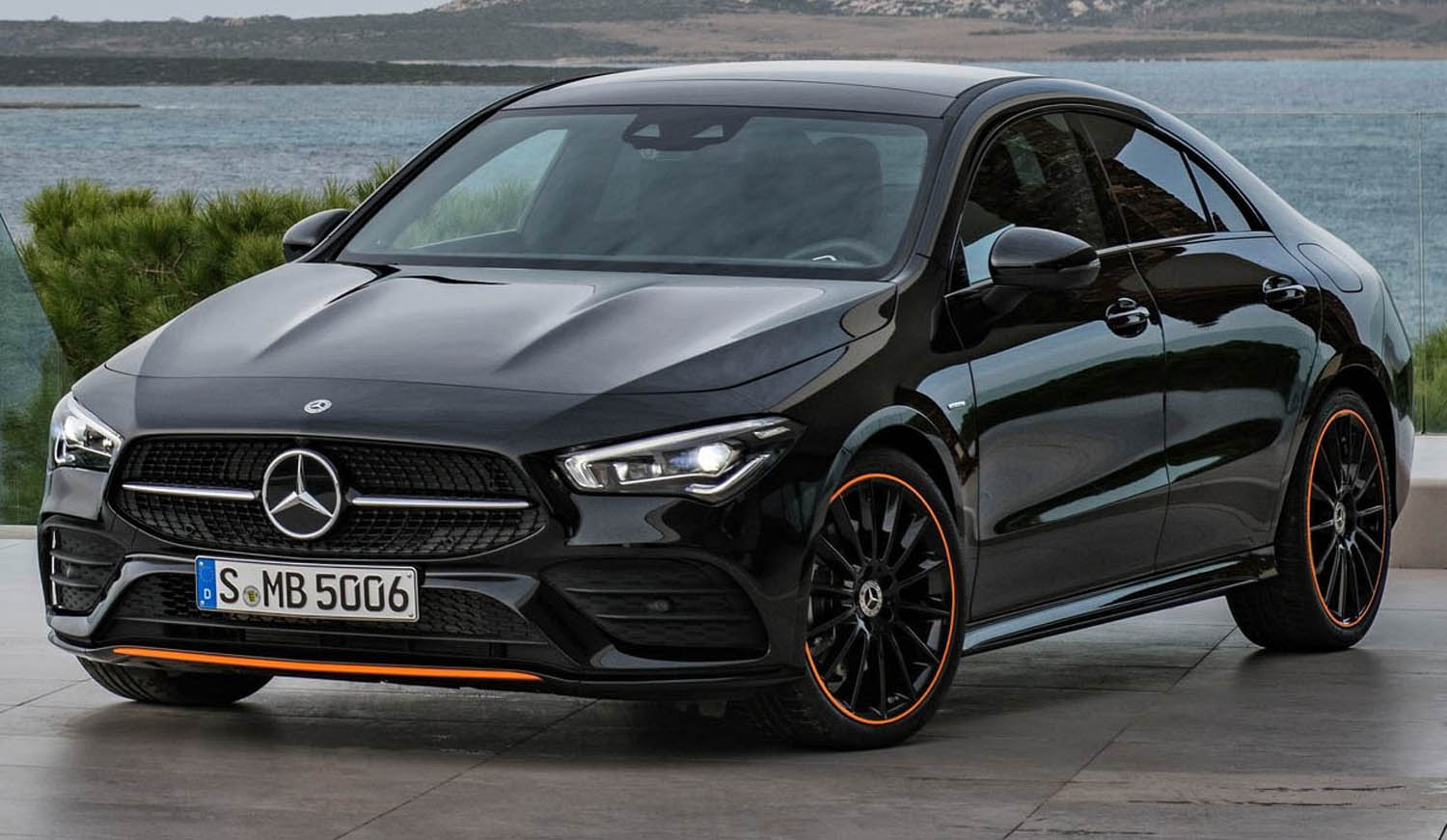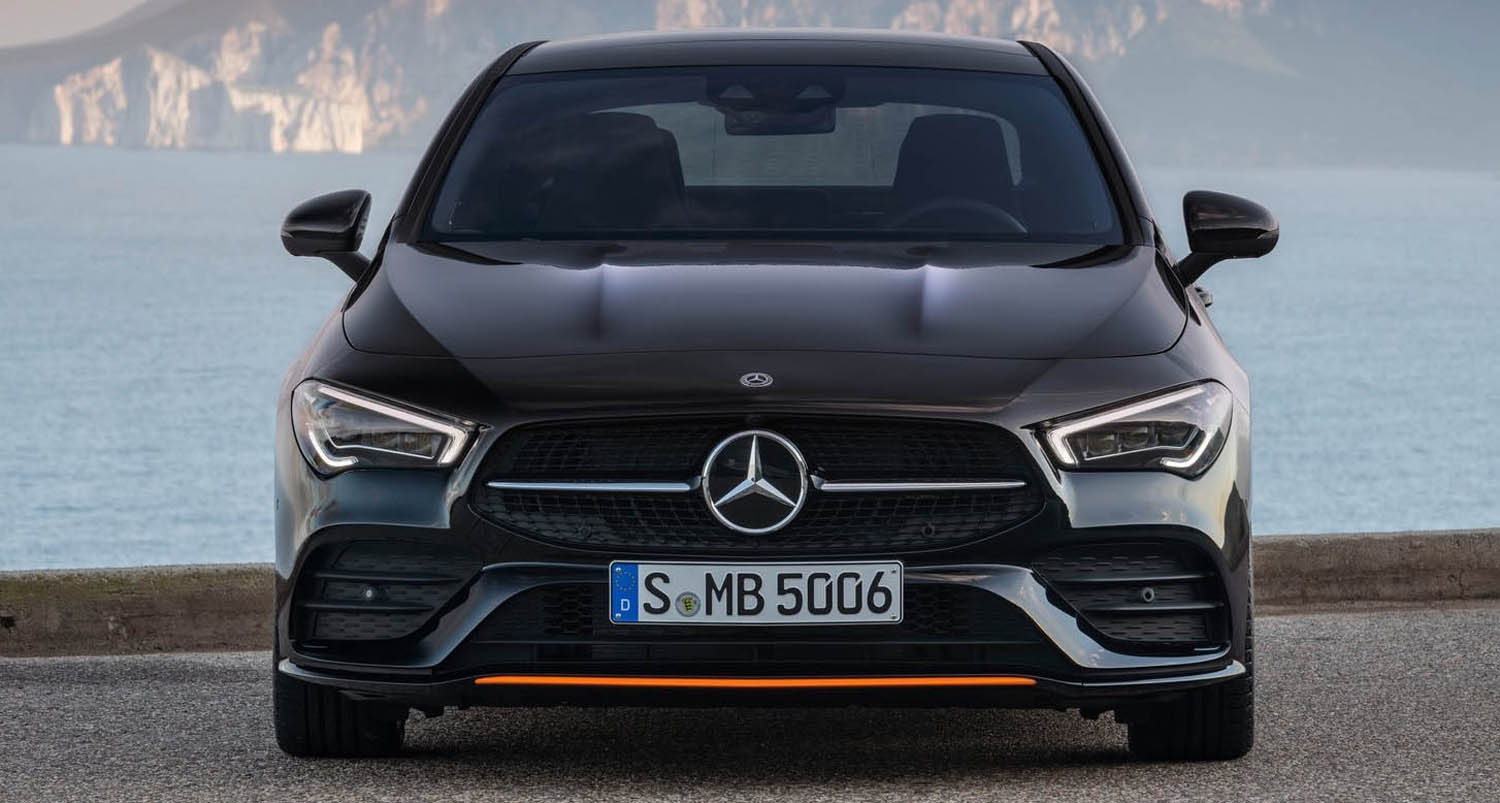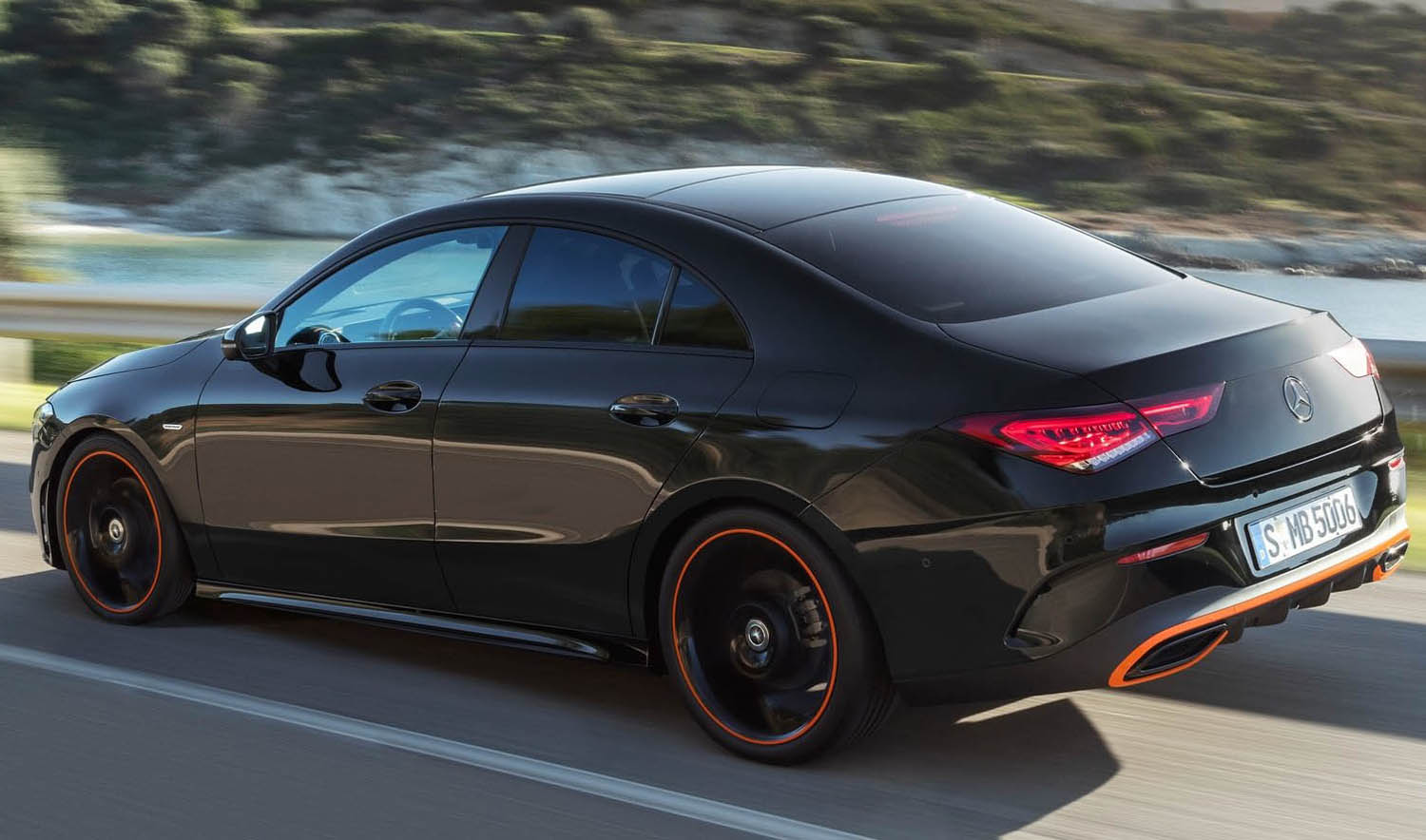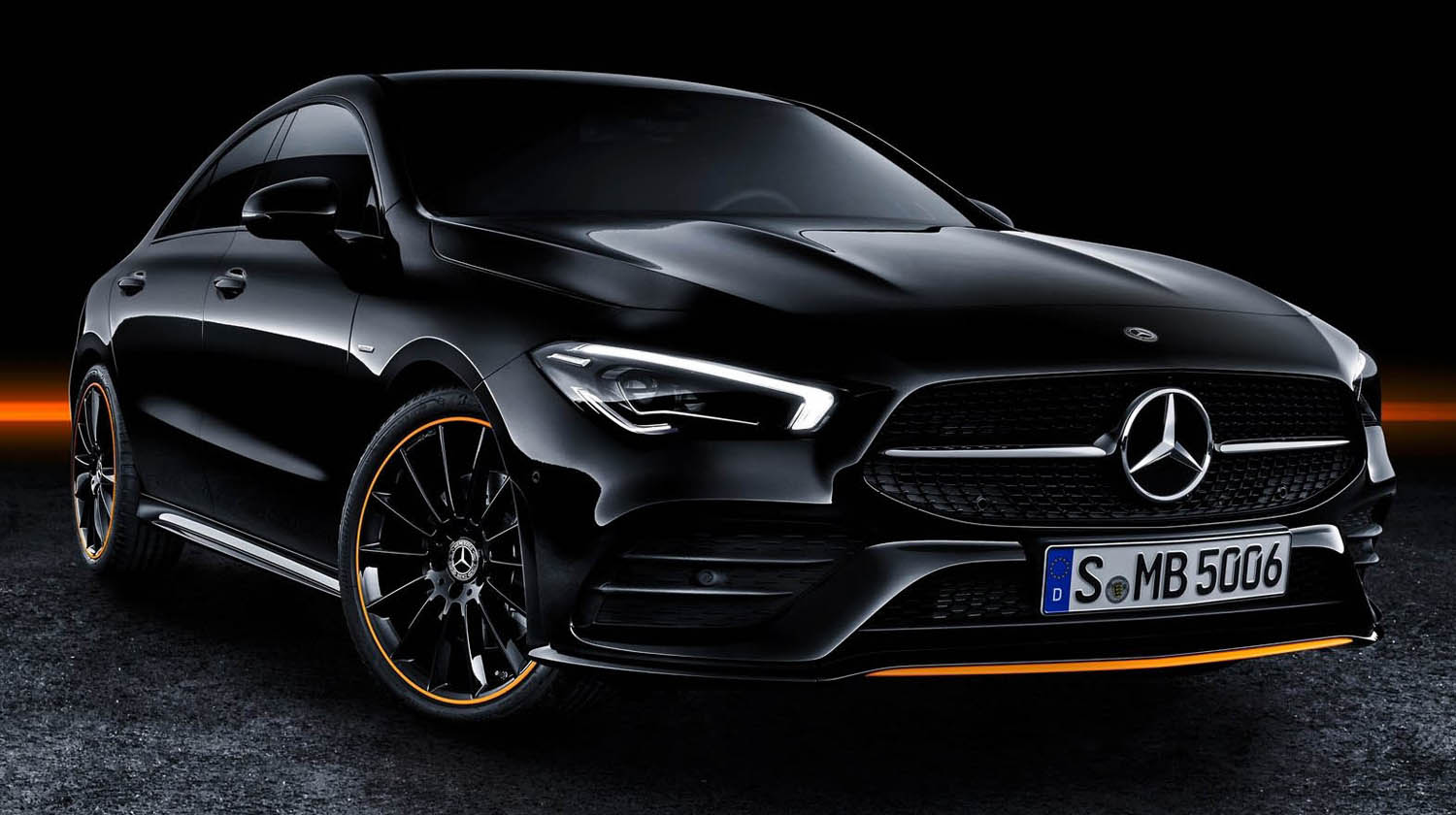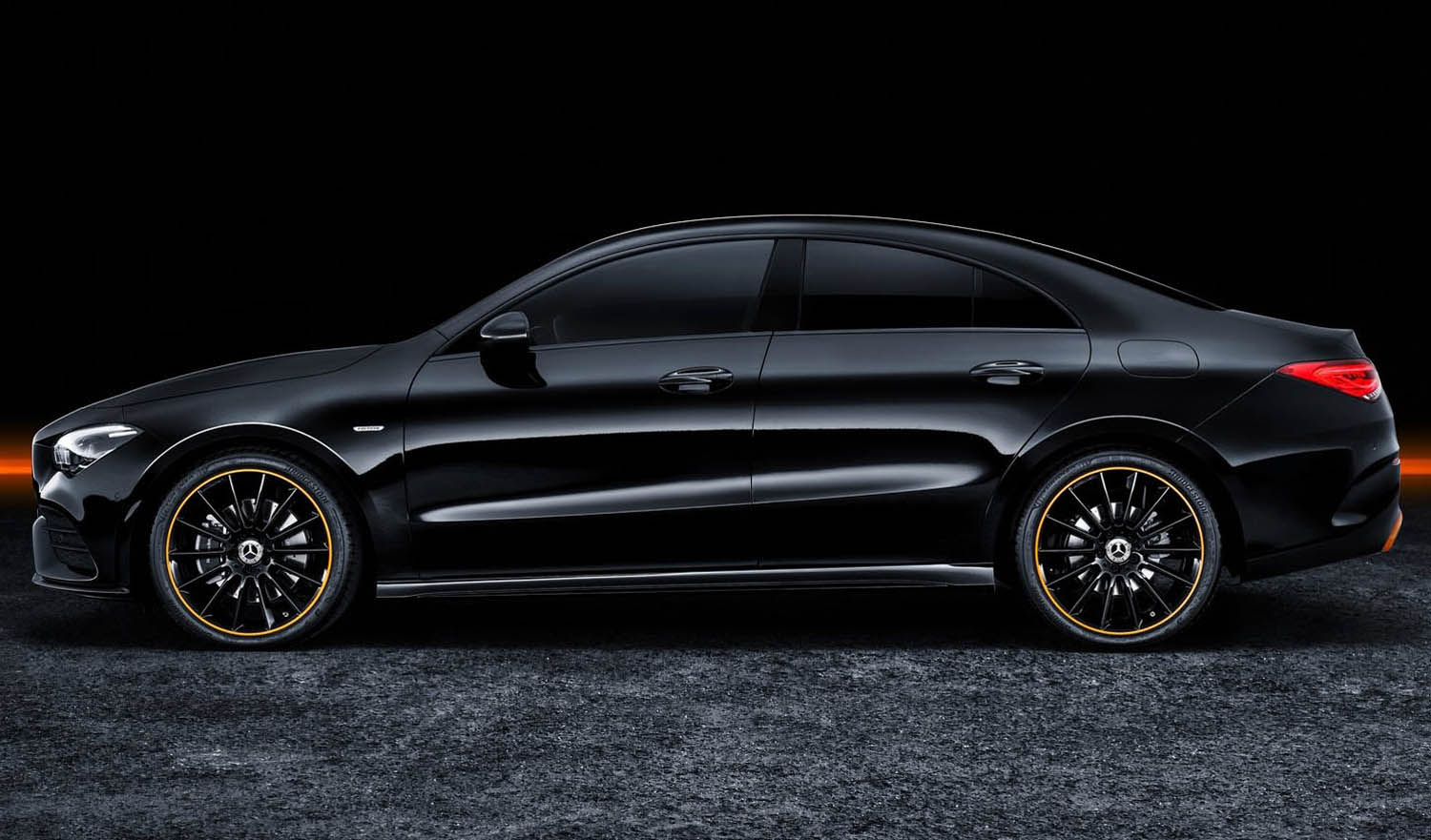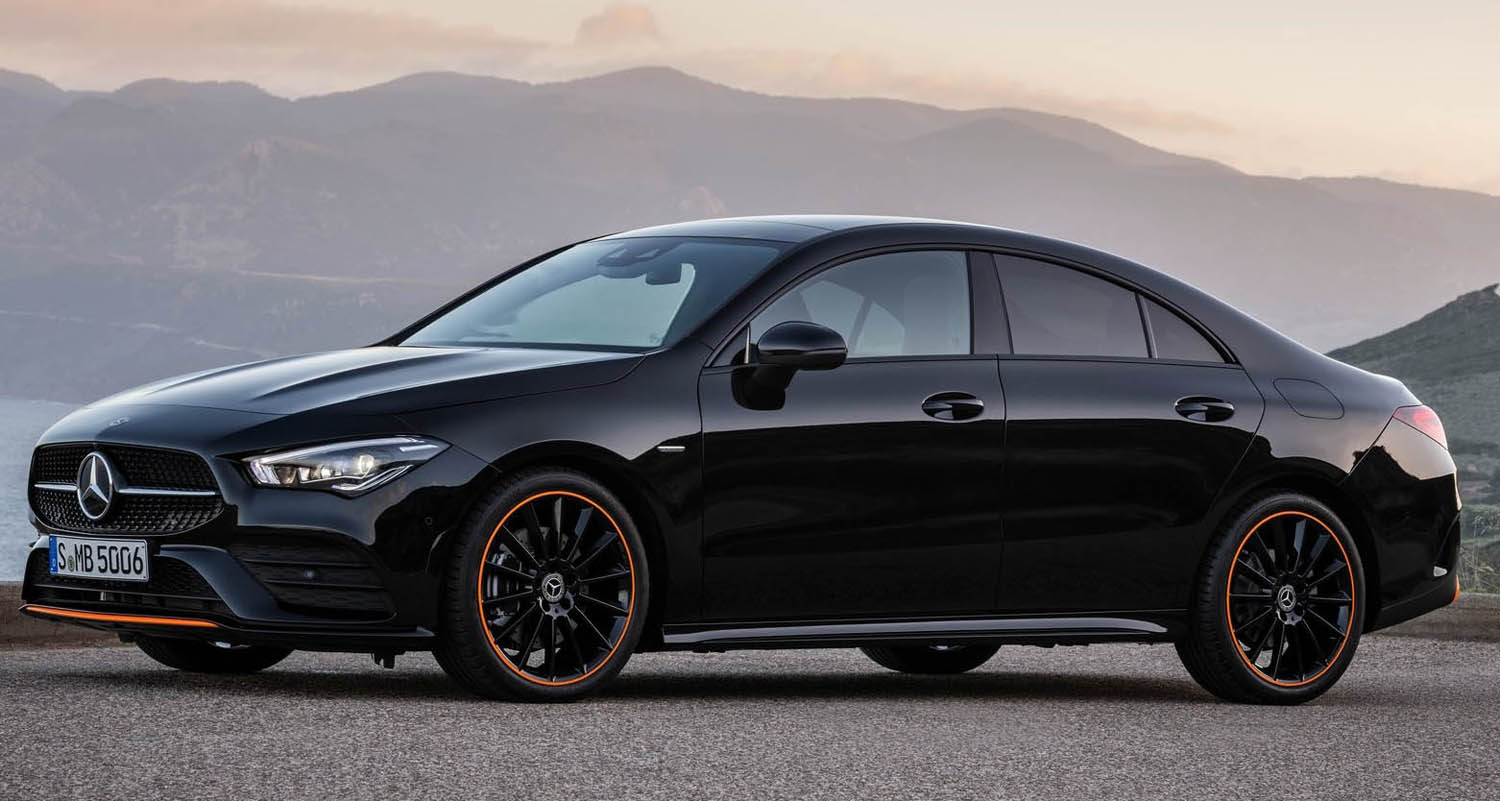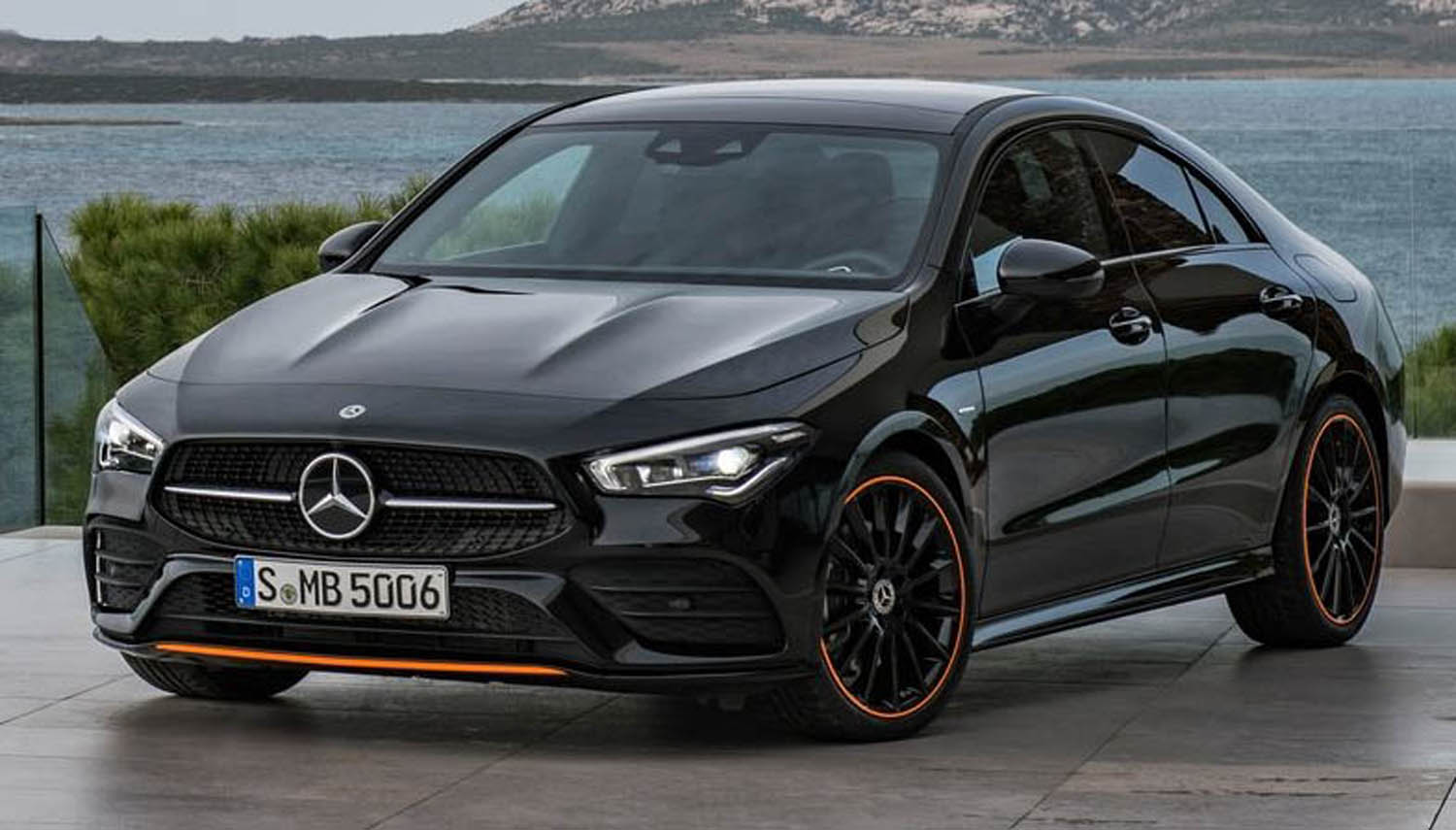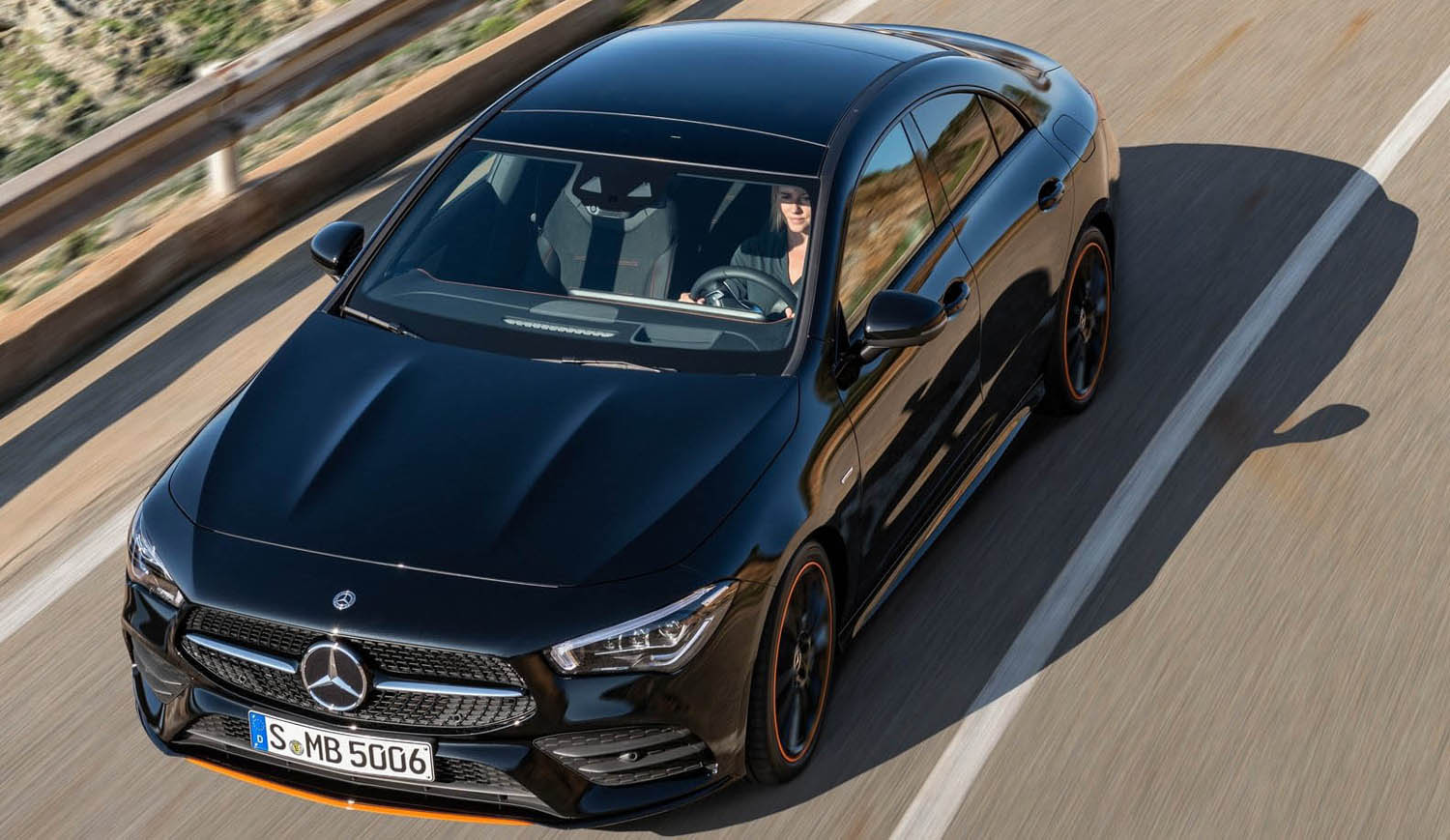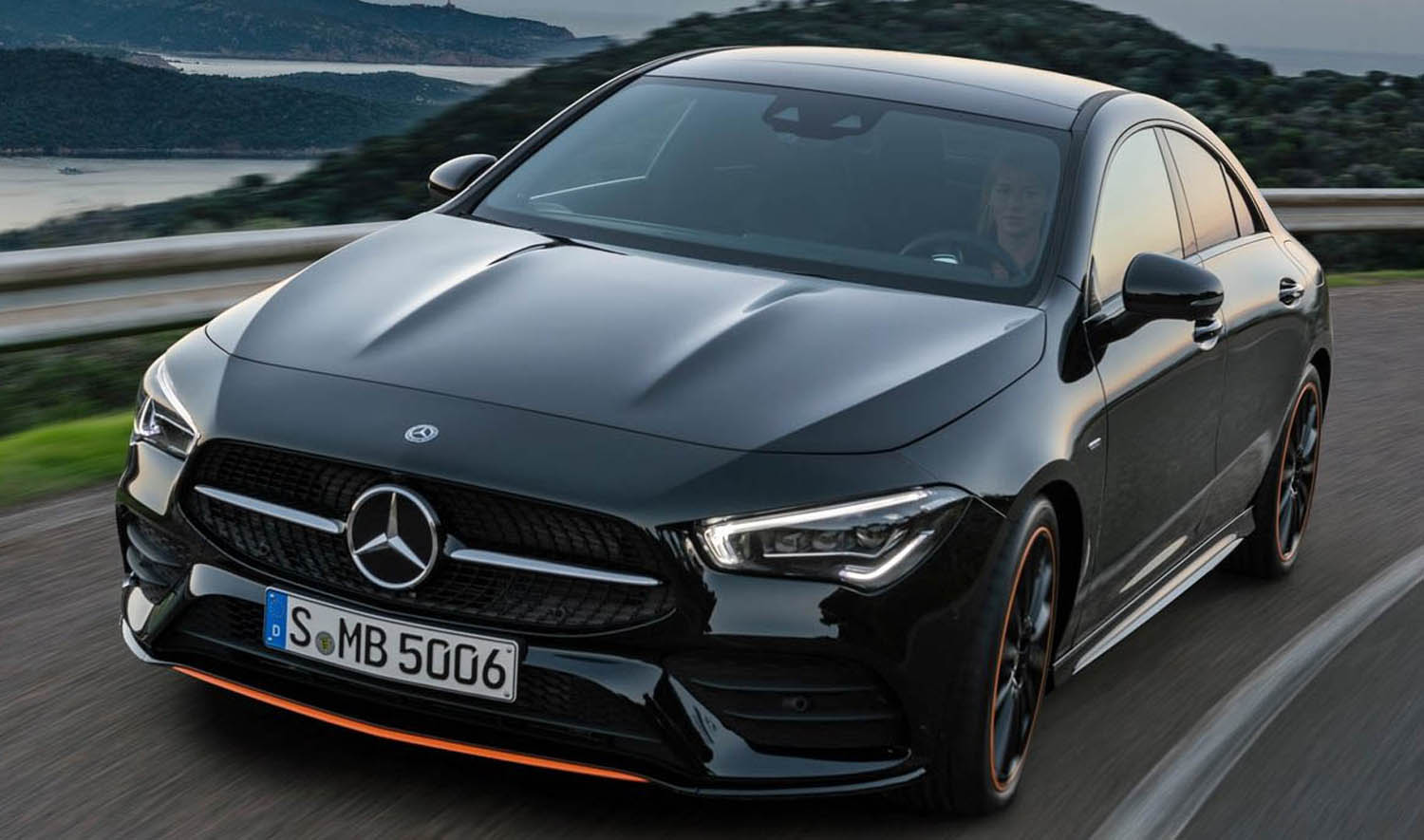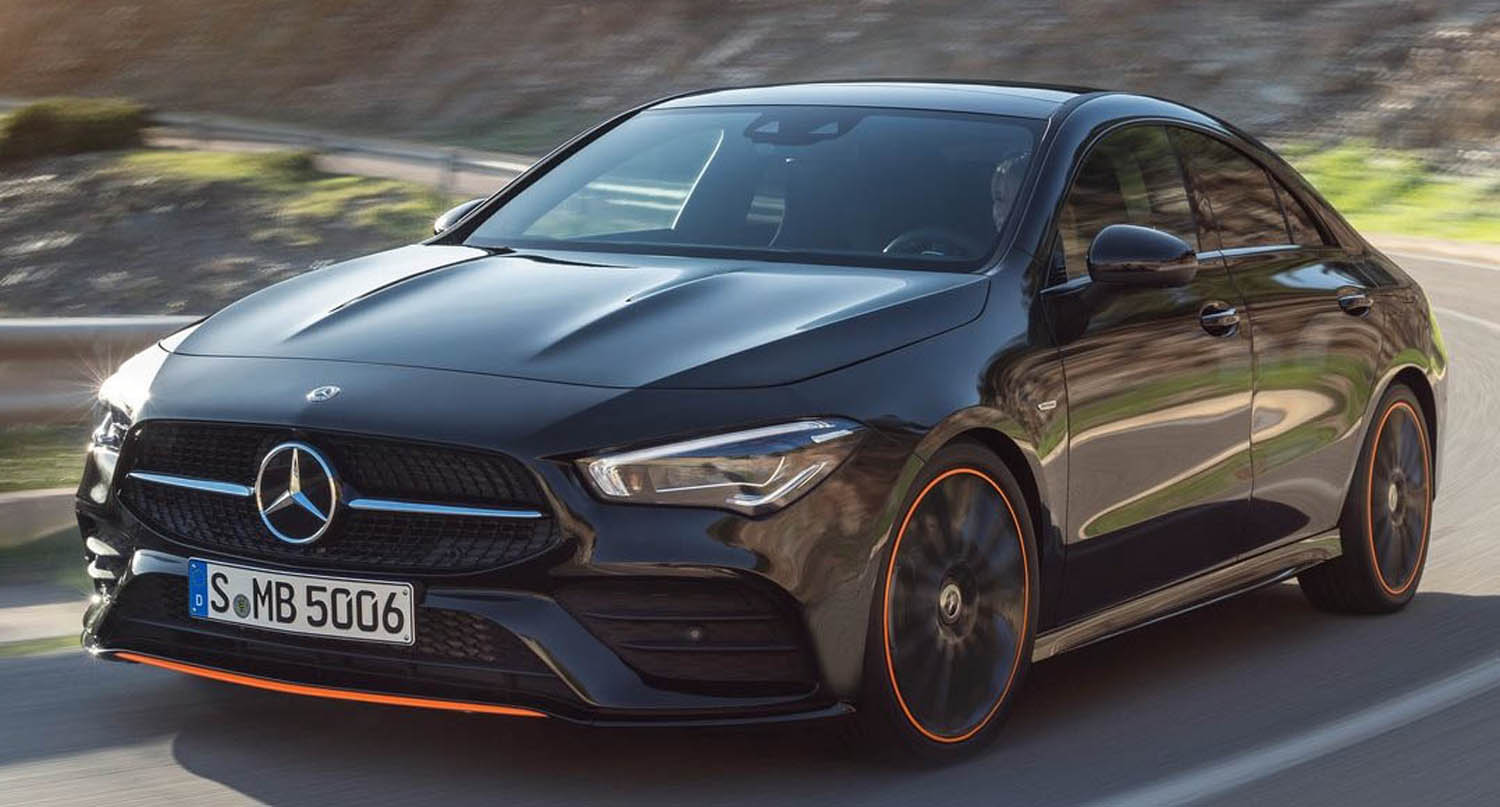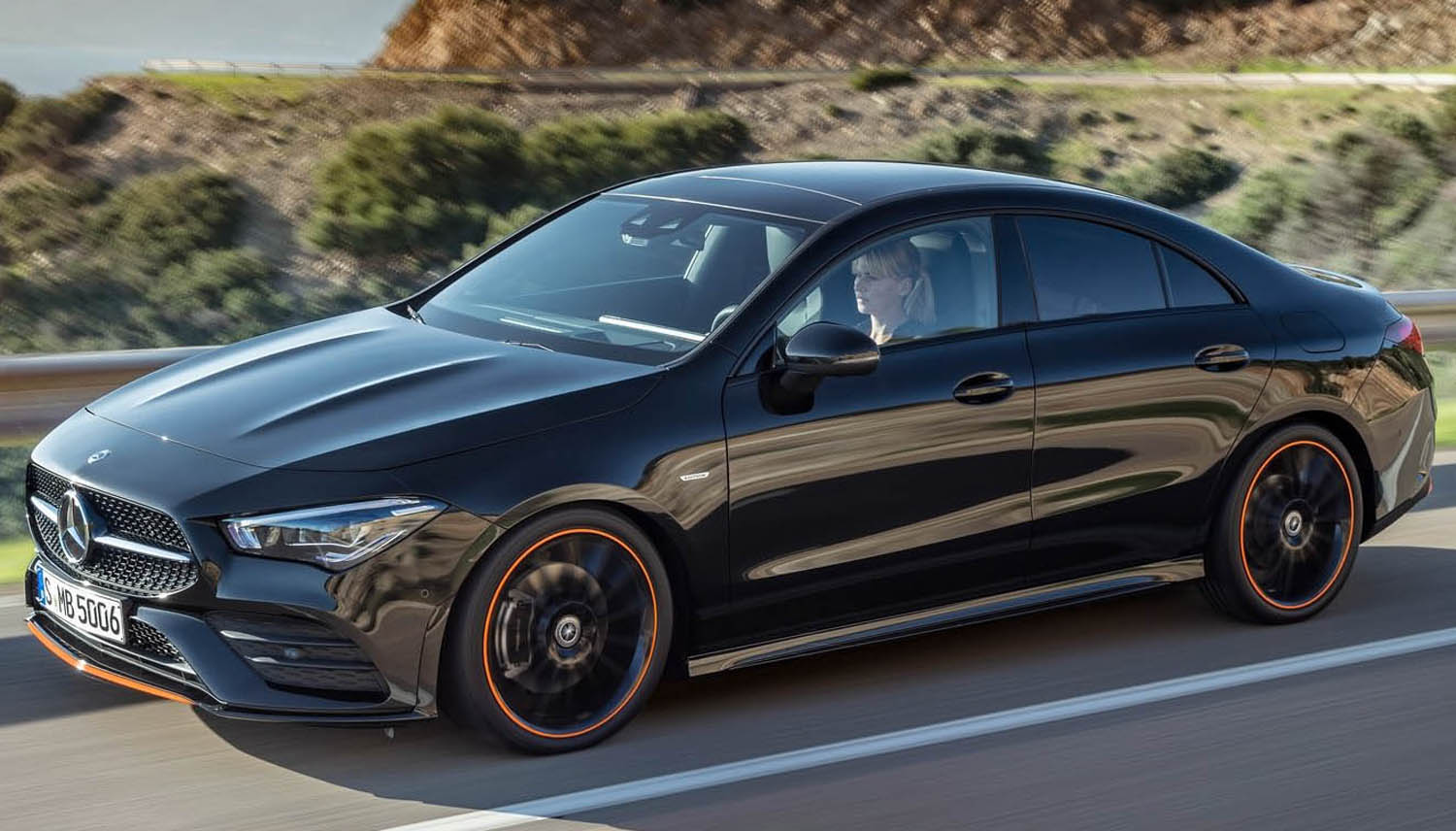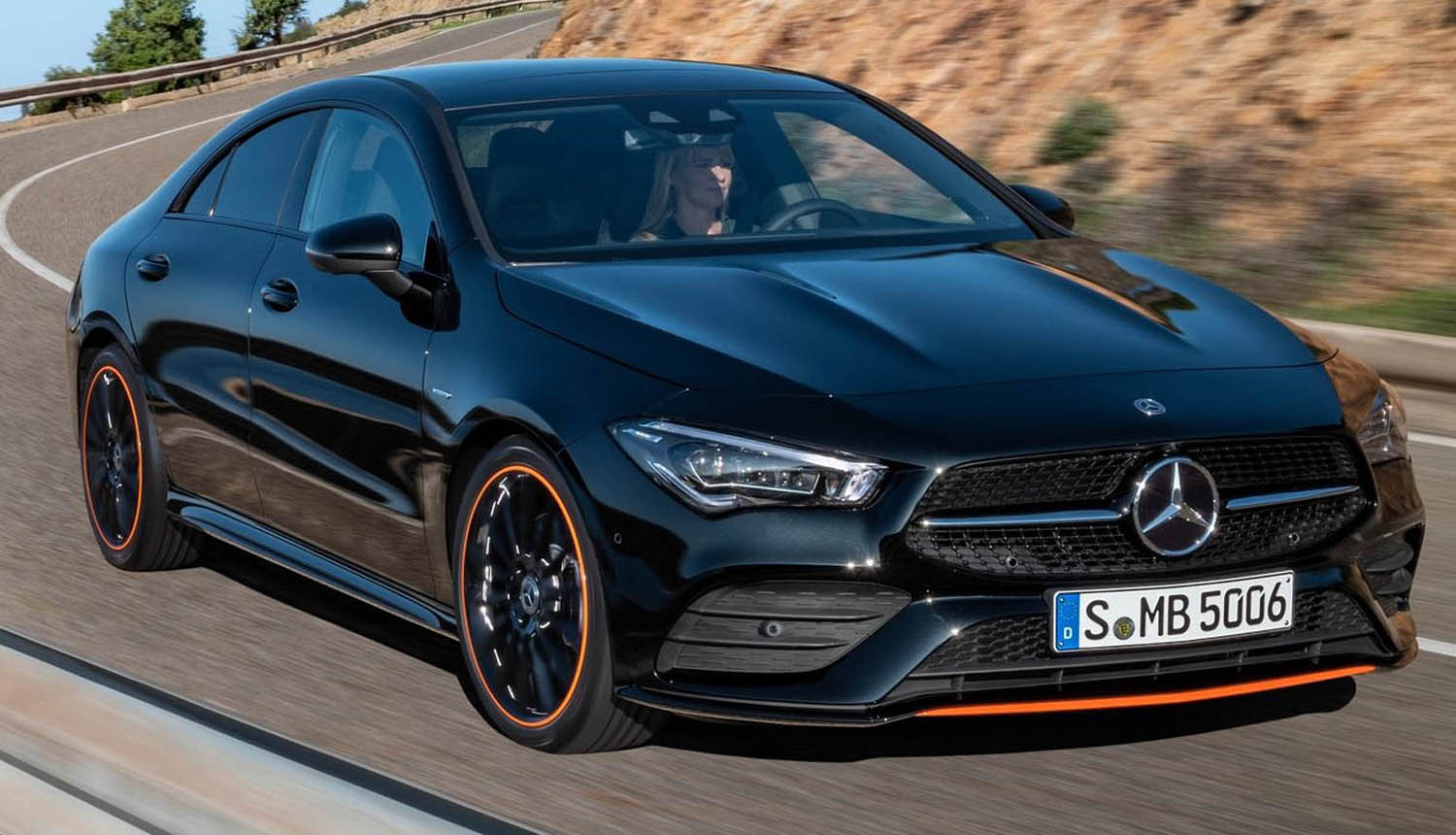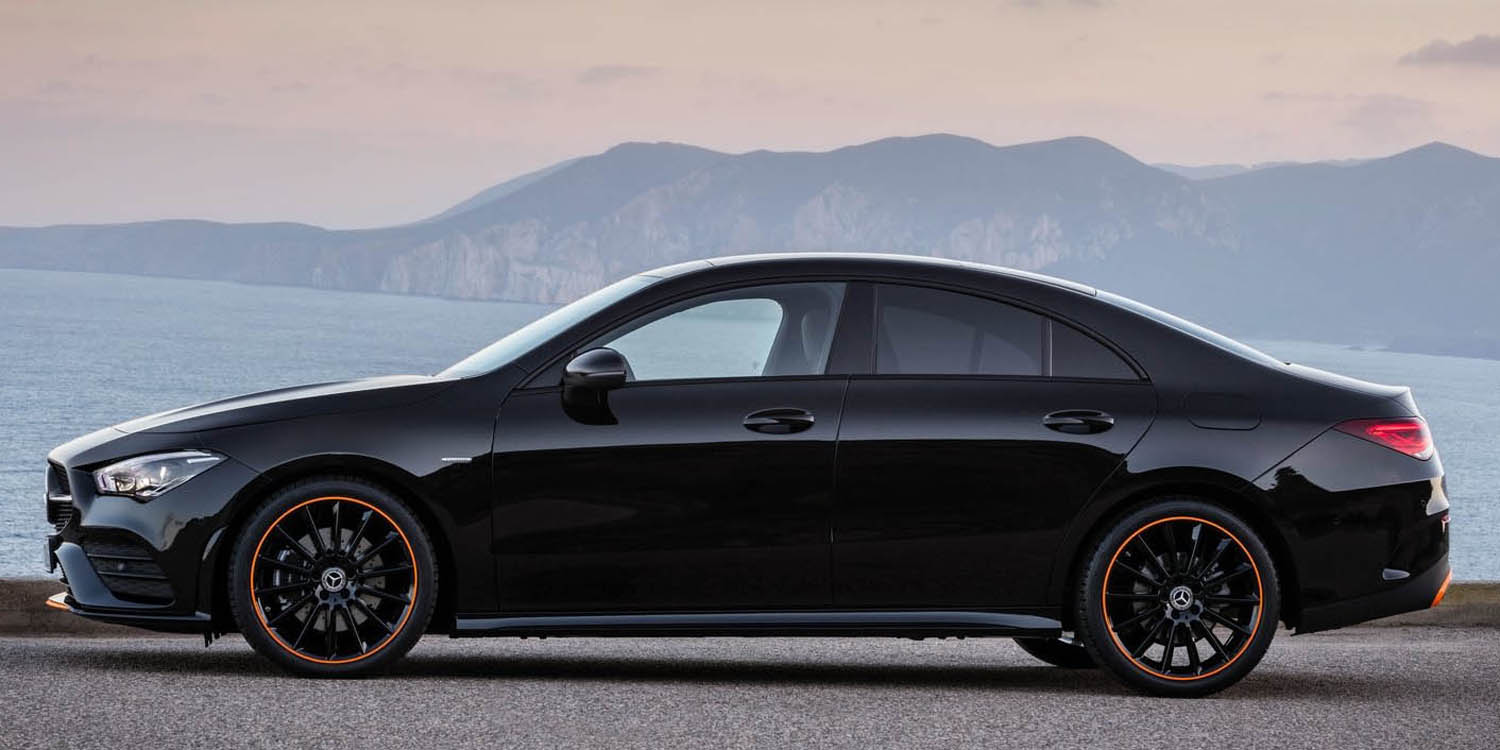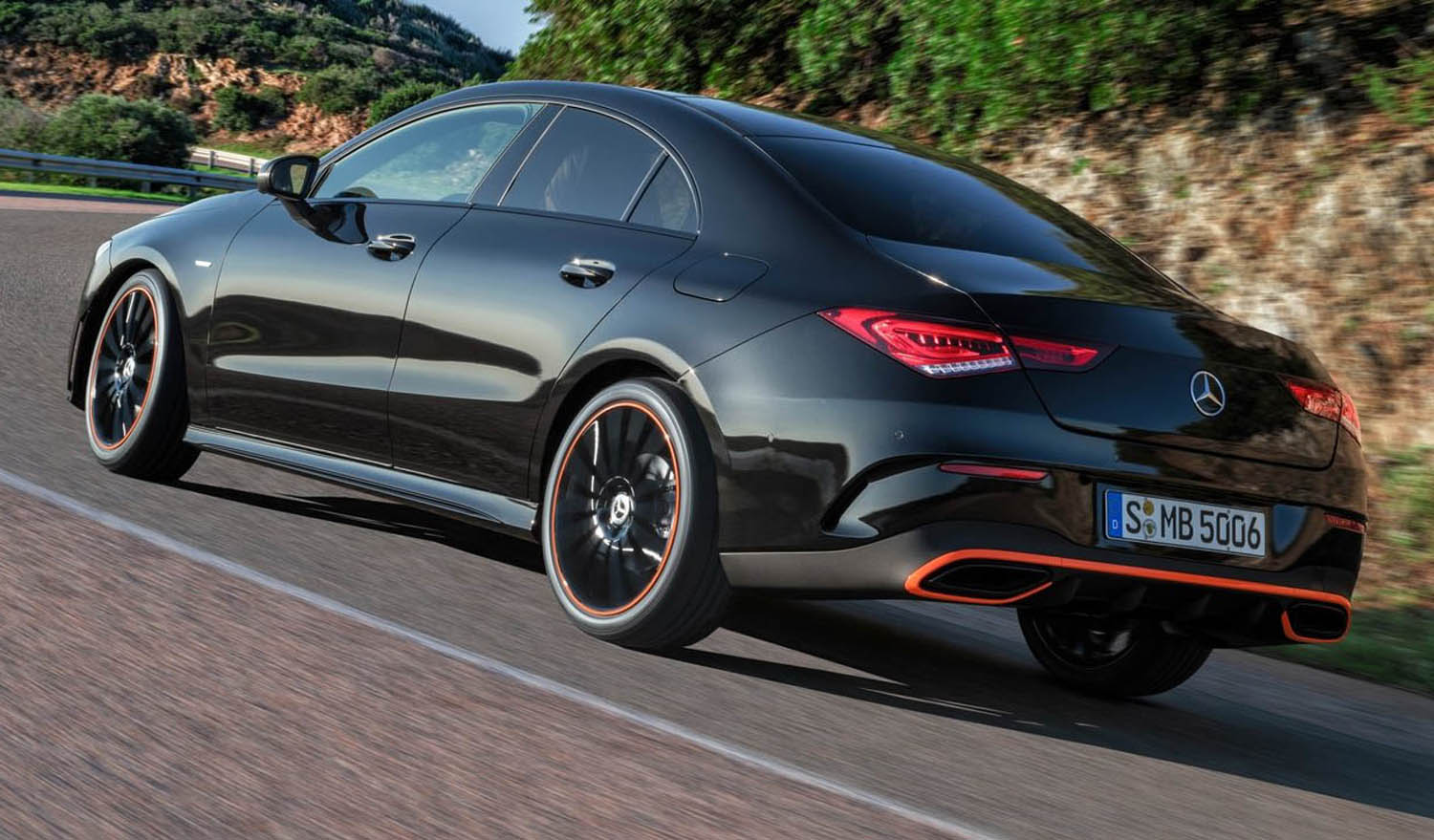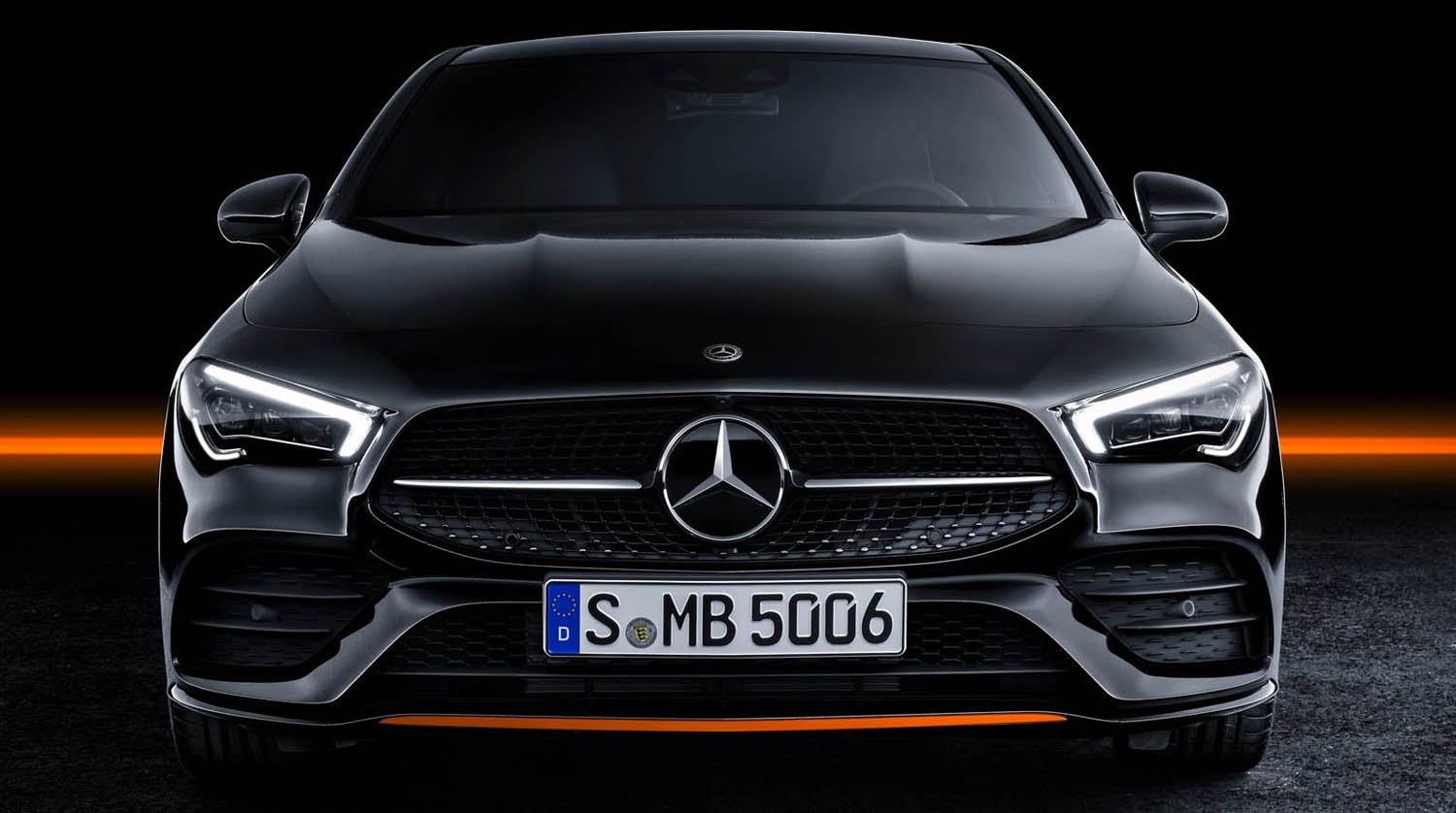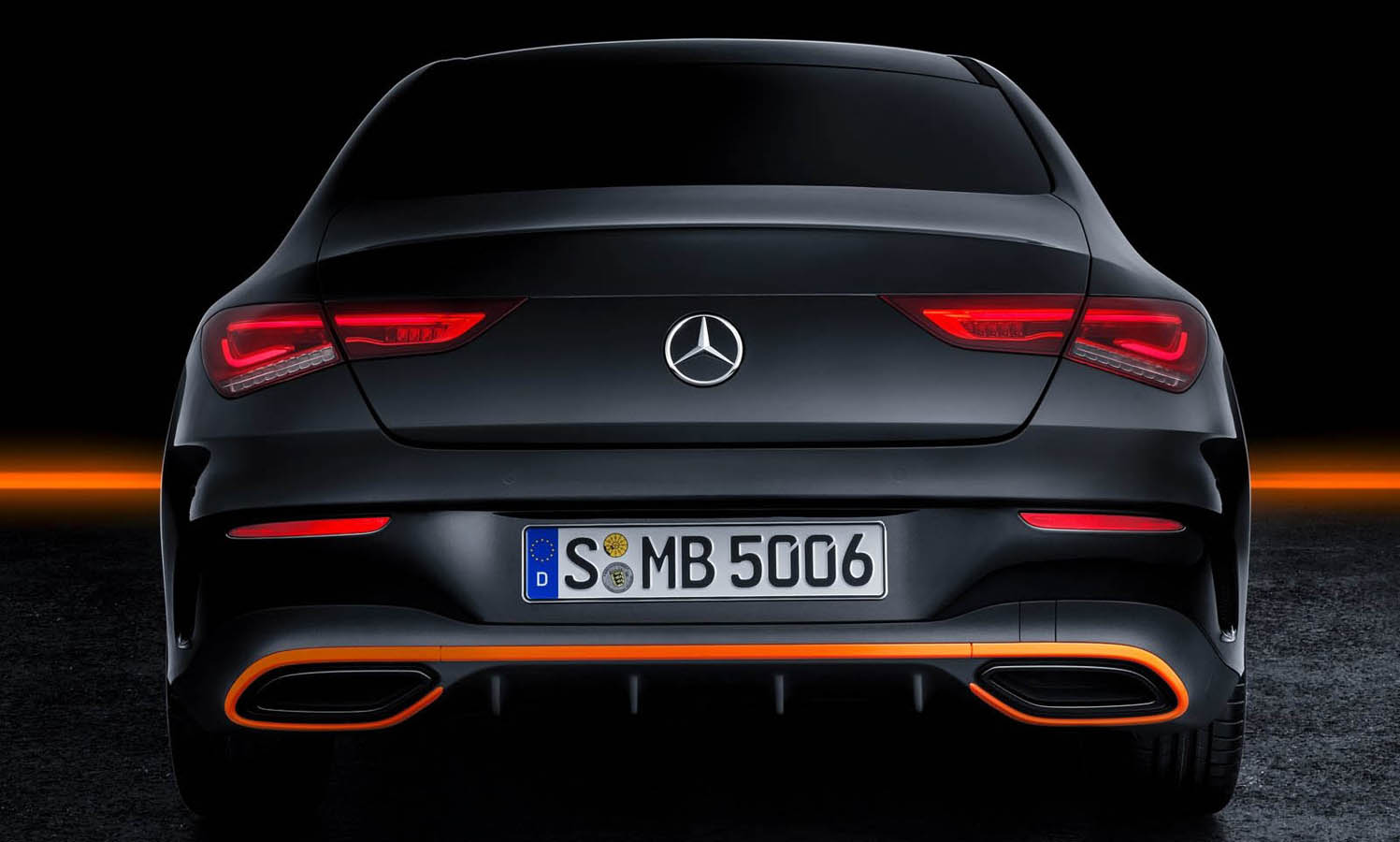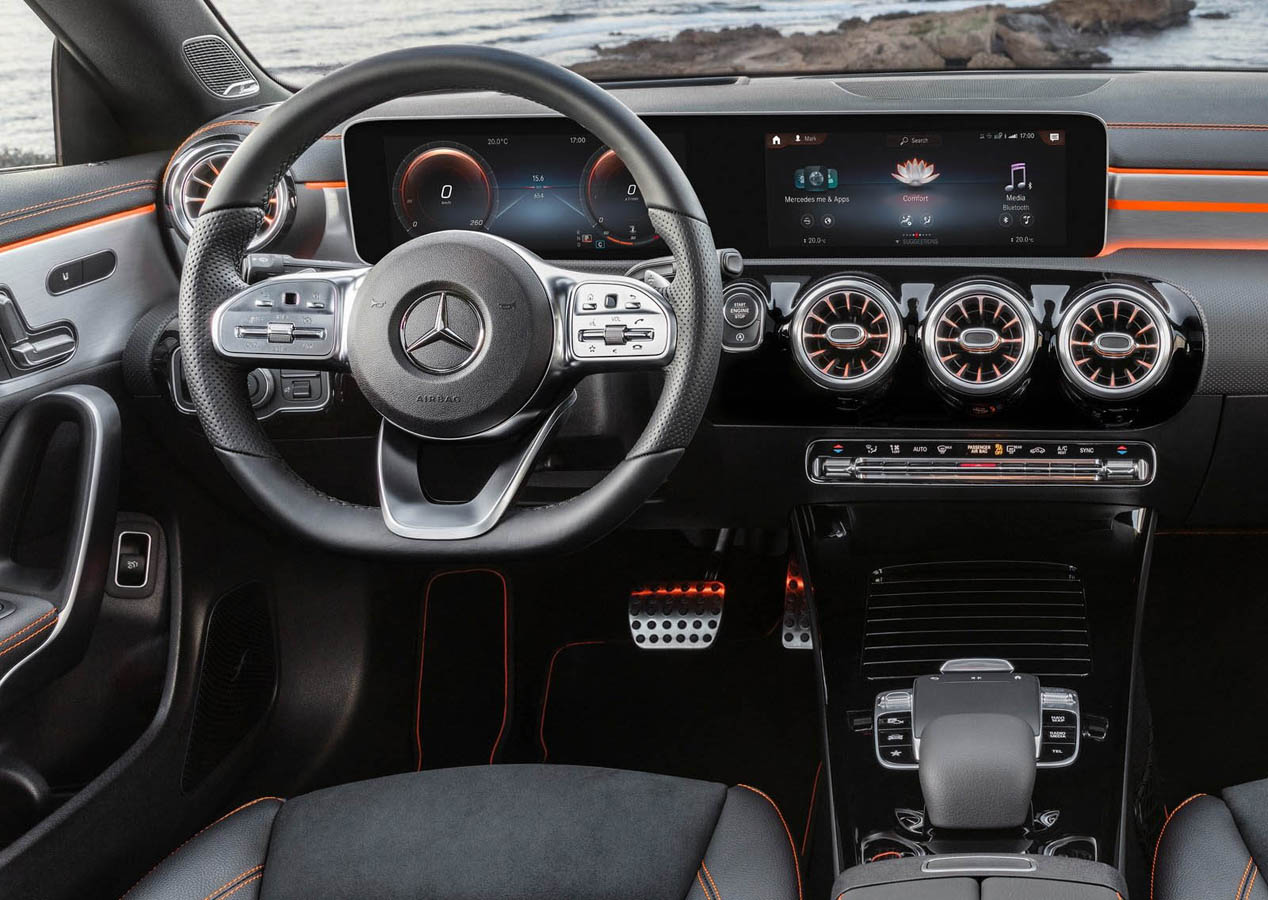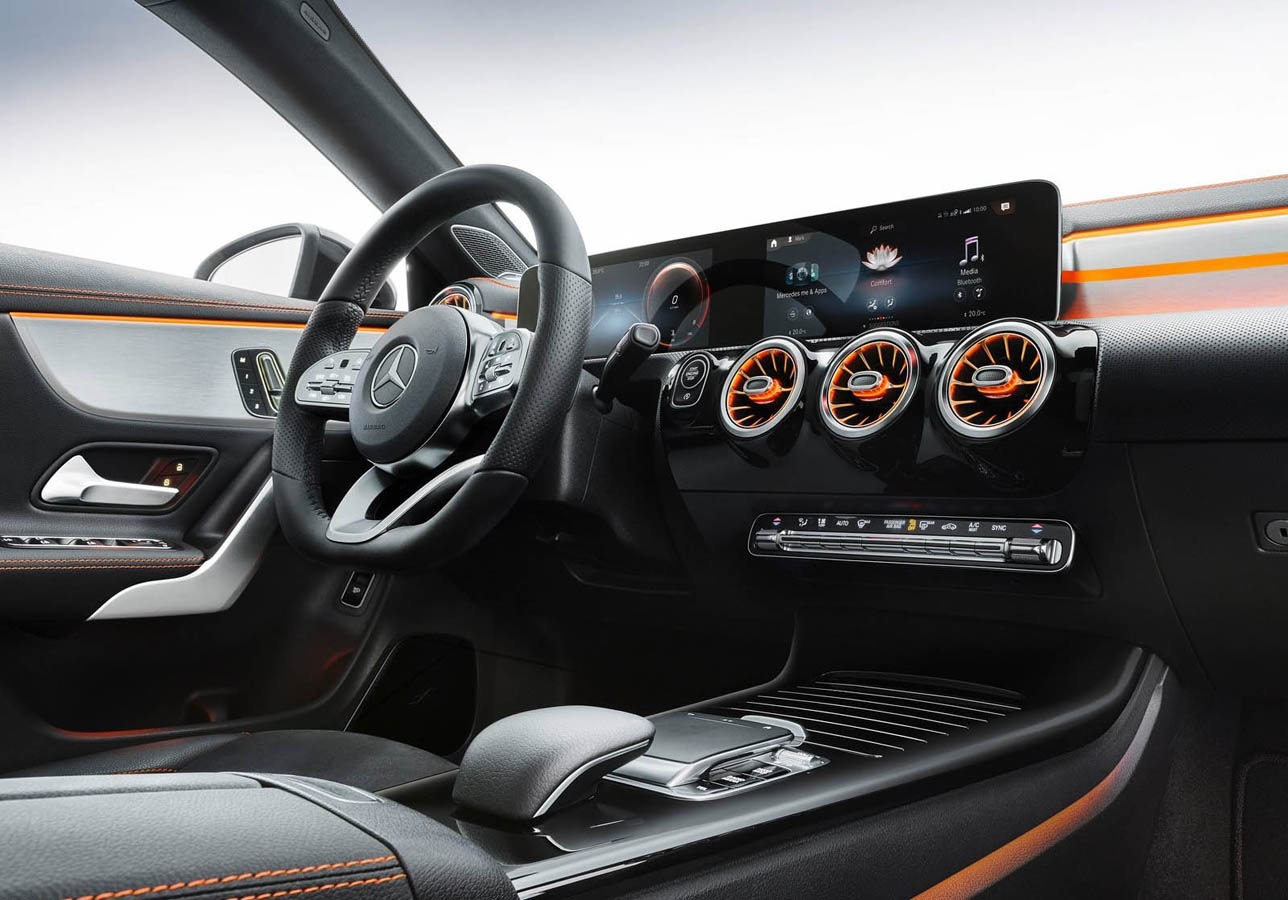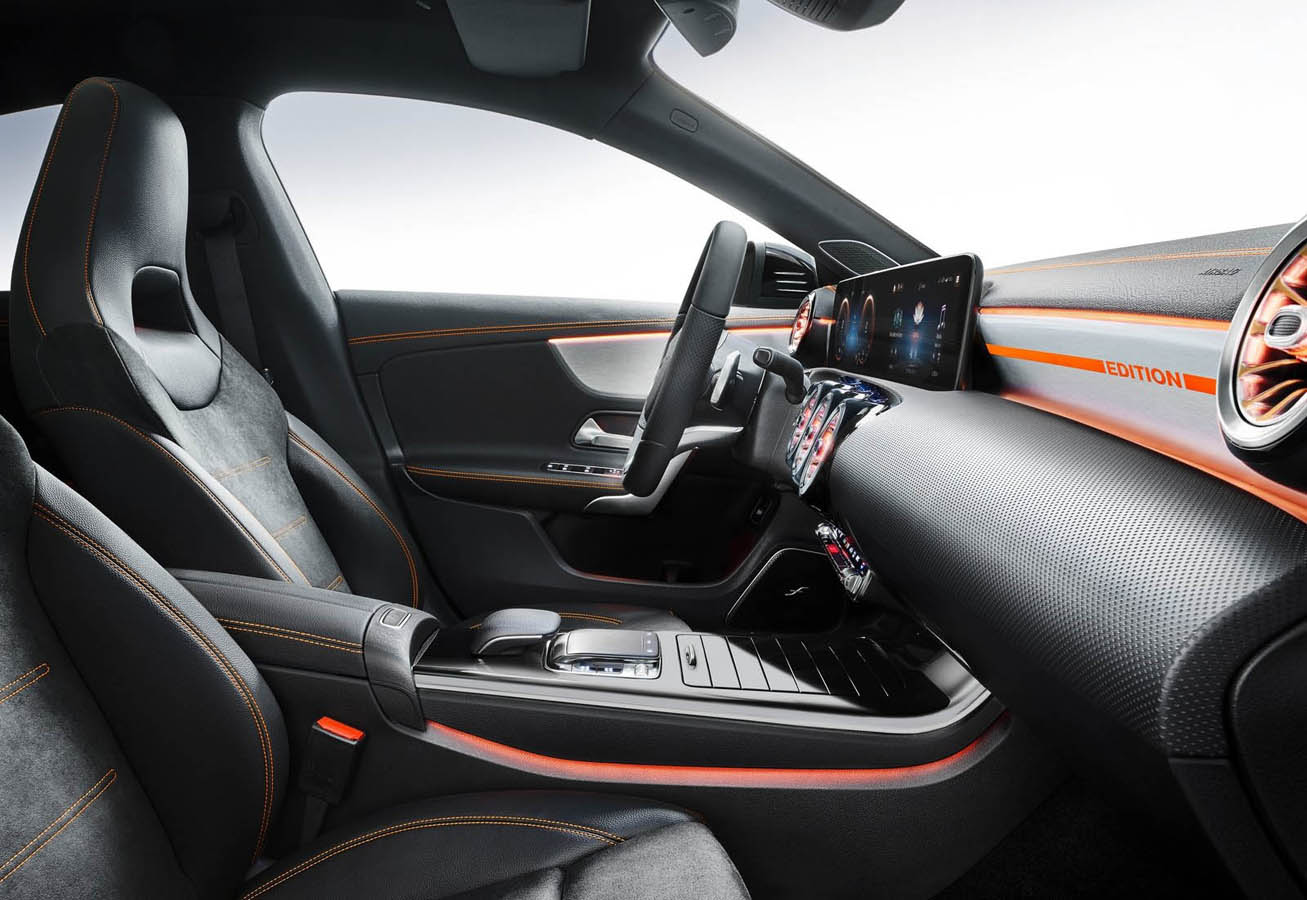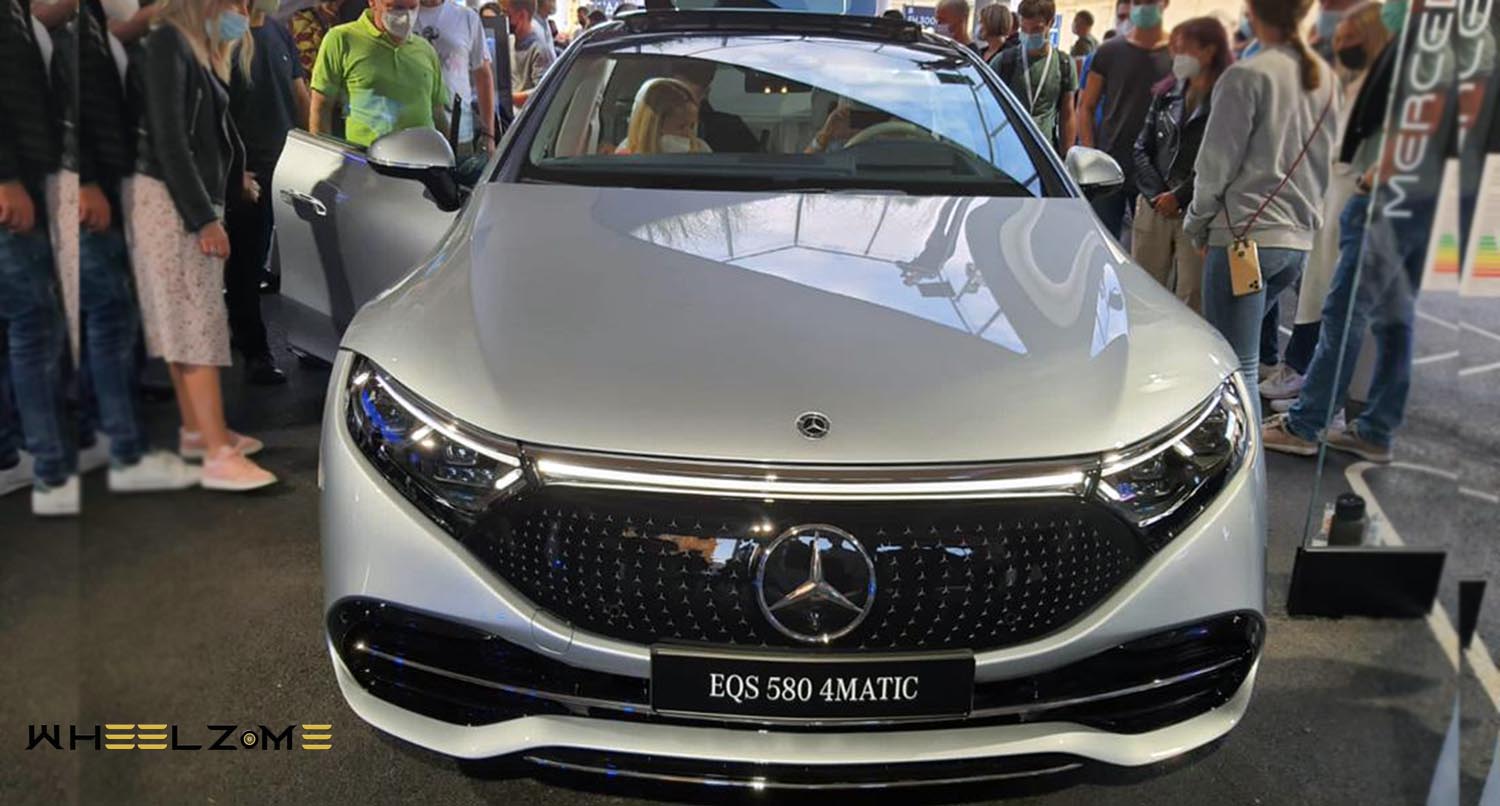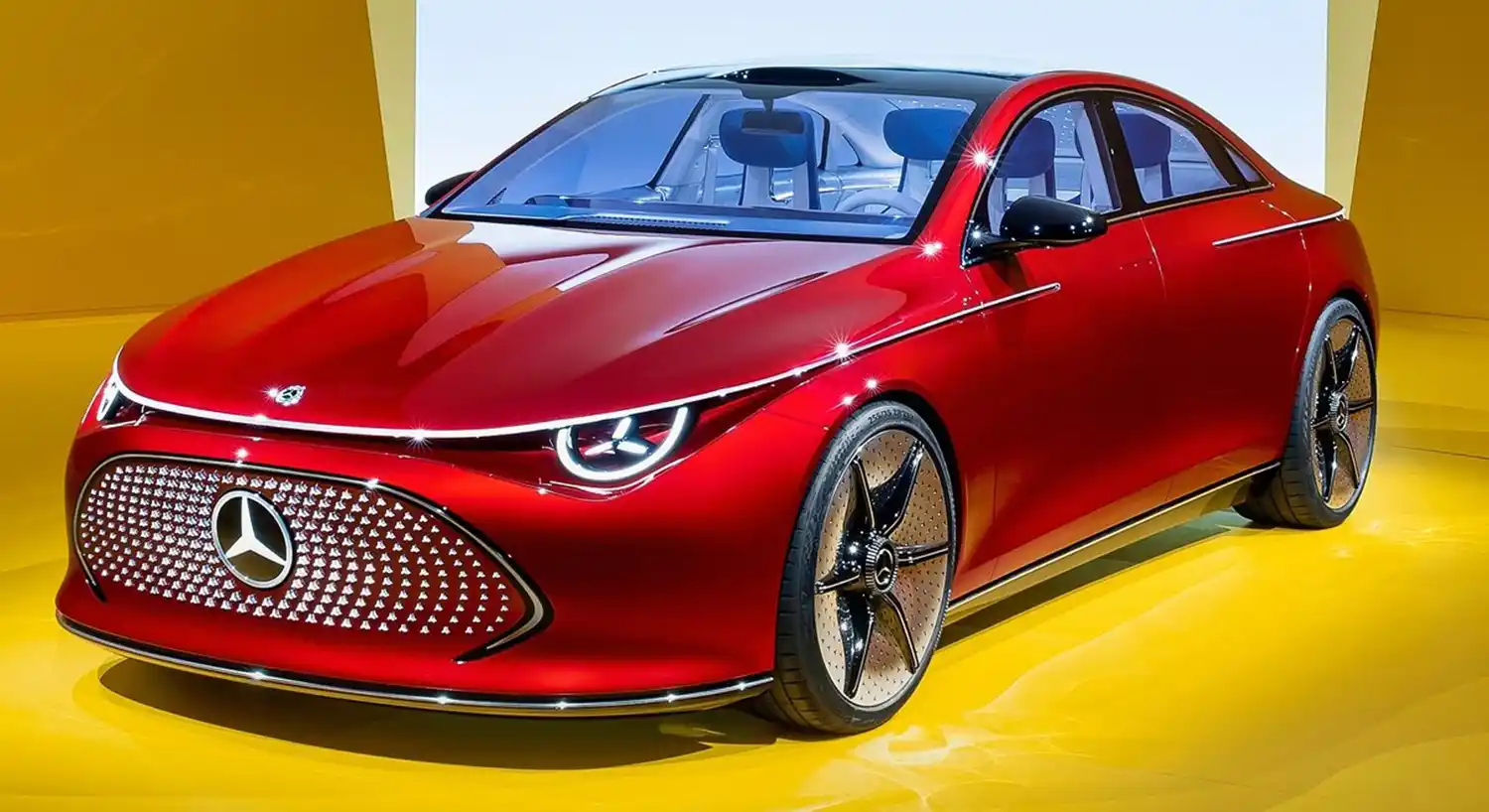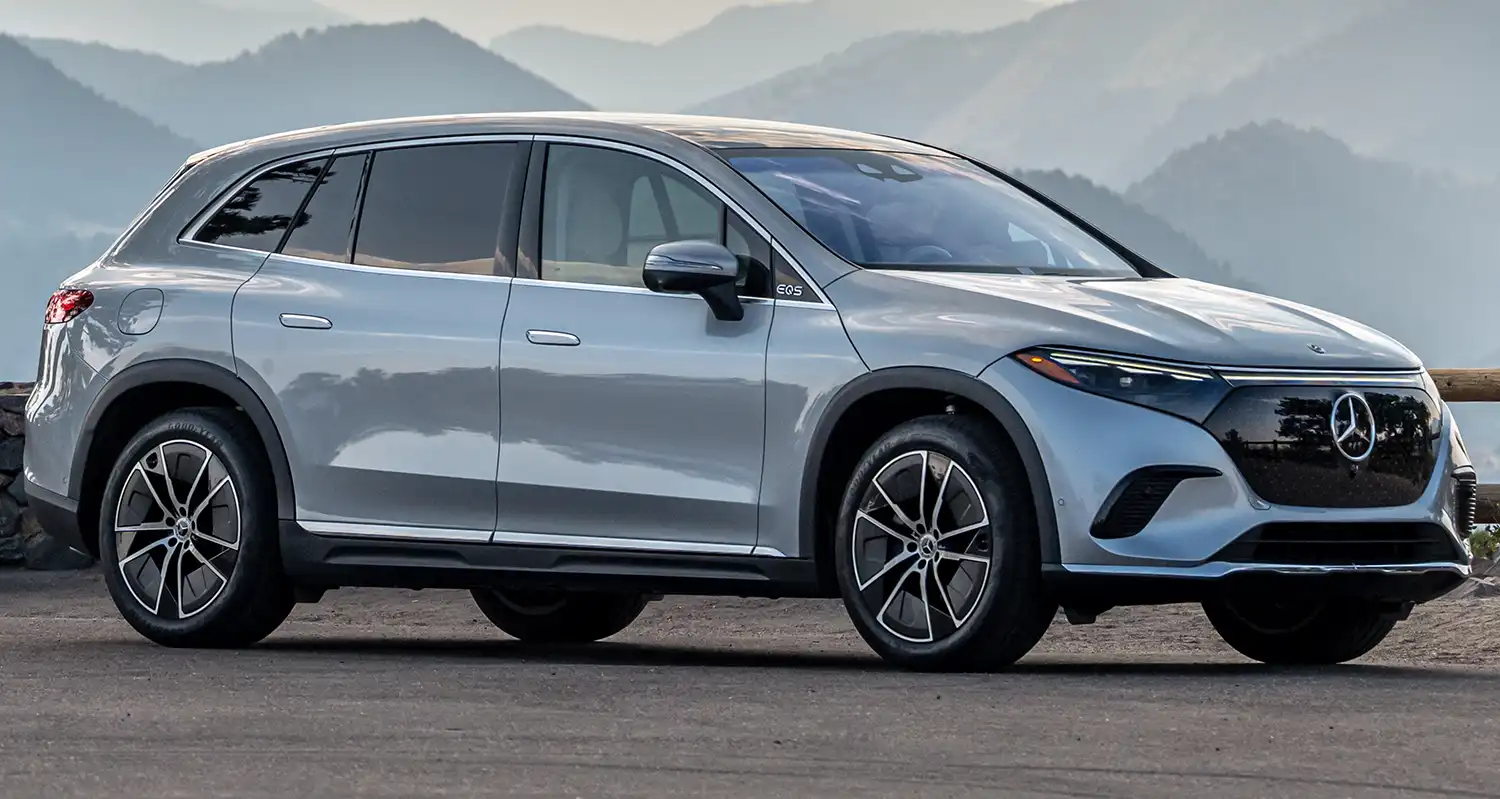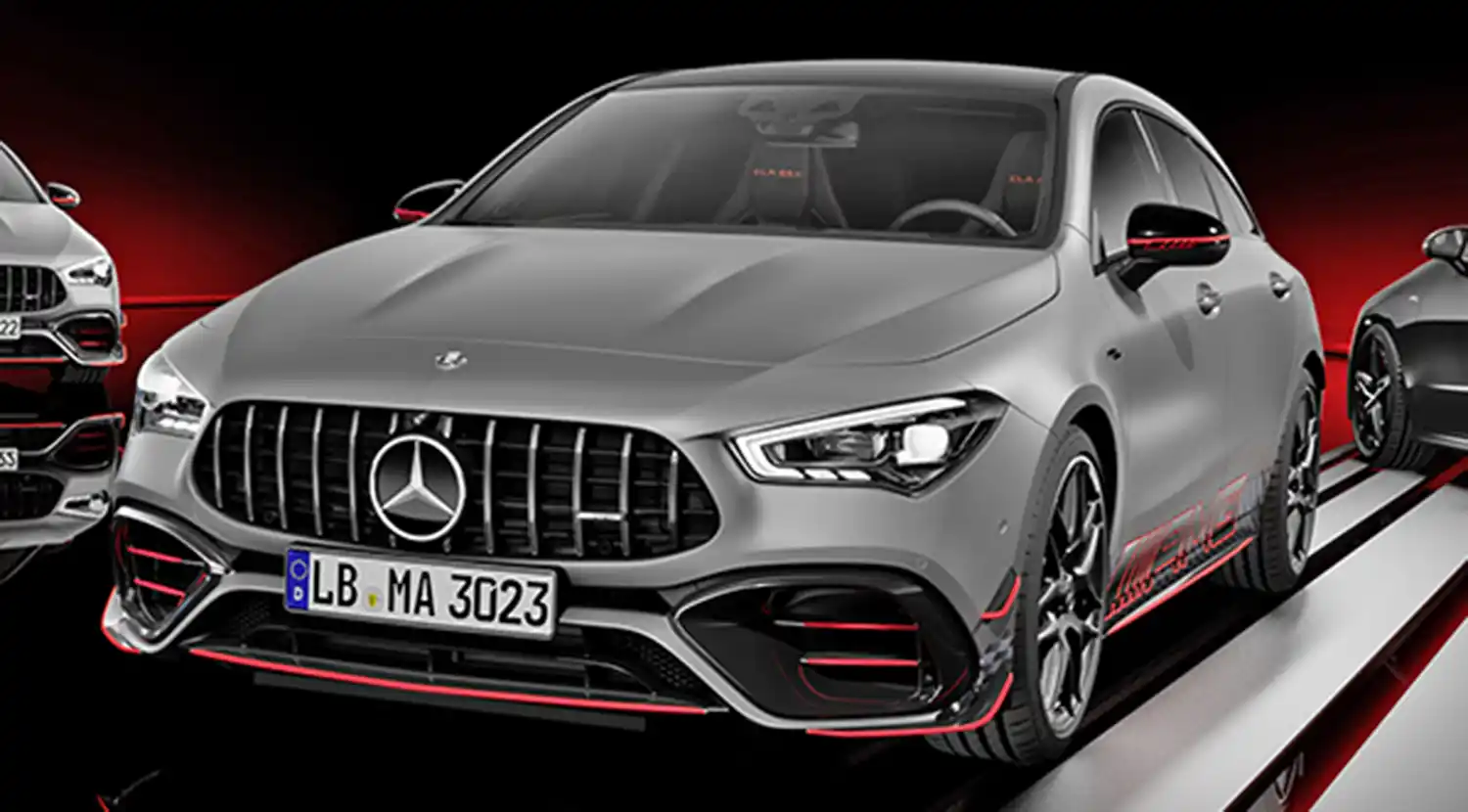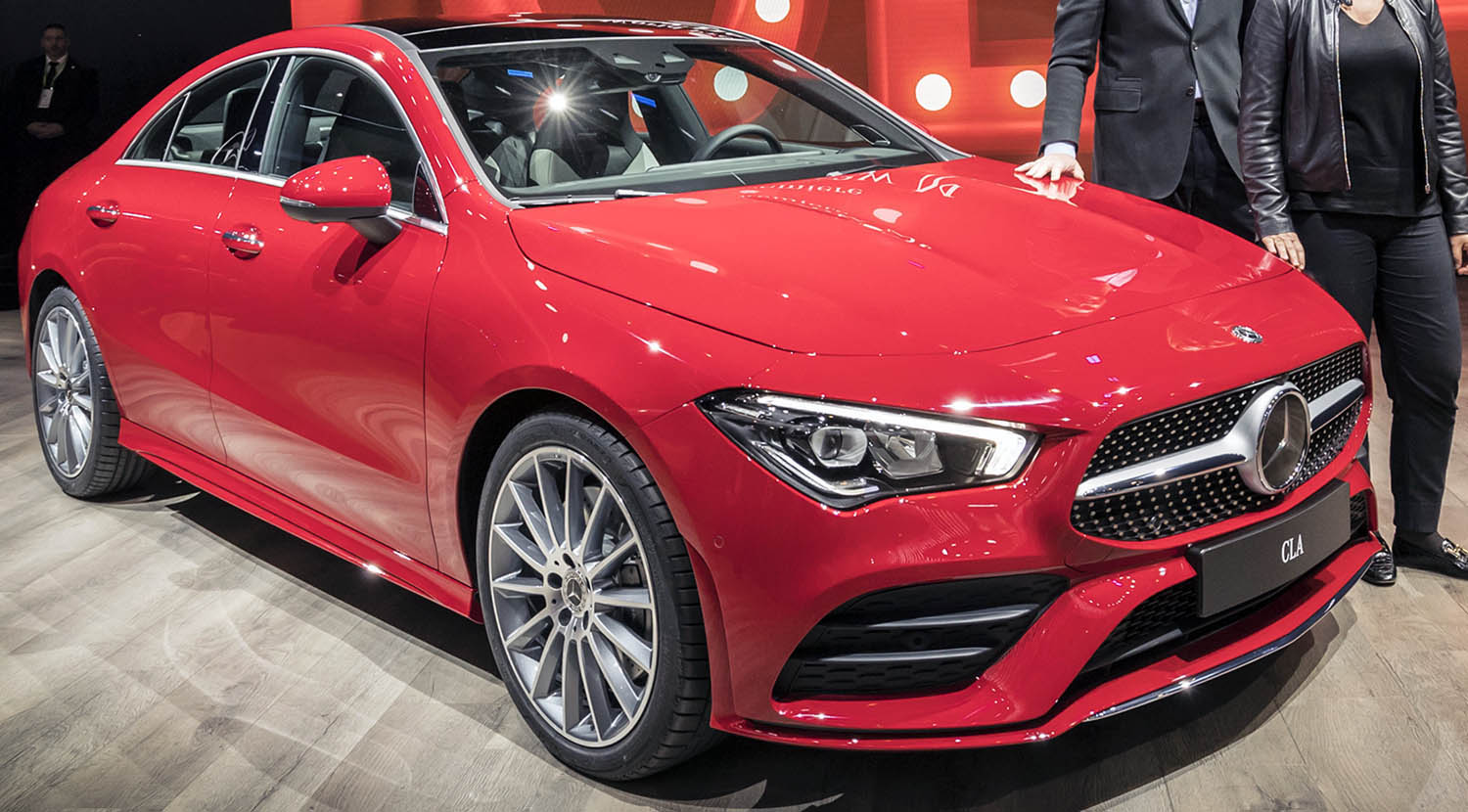
The new Mercedes-Benz CLA Coupé is the most emotive vehicle in its class. The design underlines the coupé character with its stretched form and design elements such as the bonnet with powerdomes or the rear licence plate which has been moved down. As such it does justice to its predecessor’s status as a design icon.
“As a four-door coupé, the new CLA intrigues with its puristic, seductive design and sets new standards in the design DNA of ‘sensual purity’. It is compelling for its perfect proportions, which are very close to the initial design sketches: a long, stretched bonnet, a compact greenhouse, a wide track with flared wheel arches and our typical GT rear end with a pronounced ‘Coke-bottle shoulder’,” says Gorden Wagener, Chief Design Officer of Daimler AG. “In short, the CLA Coupé has the potential to become a modern design icon.”
The combination of the long, stretched entry line above the windows and frameless doors give the Mercedes-Benz CLA Coupé its unmistakeable sporty and elegant character. Forming the front end is the striking front section which is raked forwards like a shark nose with a long, stretched bonnet featuring powerdomes.
The front: face of a classic sports car
Flat headlamps with the striking daytime running lamps together with the low slung bonnet and the diamond radiator grille with central star create the vehicle’s sporty face, which has clear echoes of classic Mercedes-Benz sports cars. The two-piece, narrow tail lamps and the number plate housed in the bumper on the rear emphasise the width of the Mercedes-Benz CLA. The car thus appears flatter and sportier and has an especially good presence on the road.
The greenhouse set back and the sporty, gently sloping GT rear that culminates in a striking spoiler lip achieve a balance between elegance and sportiness, revealing the carefully elaborated aerodynamics. The reduced lines of the side profile allow plenty of space for precisely modelled surfaces. This creates an interesting play between light and shade, which lends the vehicle a strong presence. Dispensing with the upper shaped edge of the side wall permits muscular and athletic shoulder shaping, stretching from the front wheel arch through to the sculptured rear, and culminating just above the rear wheel arch. This creates a sense of tension, as if the car is ready to jump.
Flush with the outer edge of the body, the wheels with their flared wheel arches and wide track epitomise dynamism and give the vehicle a sporty presence. This sporty tone can be emphasised even more with wheel sizes of up to 19 inches.
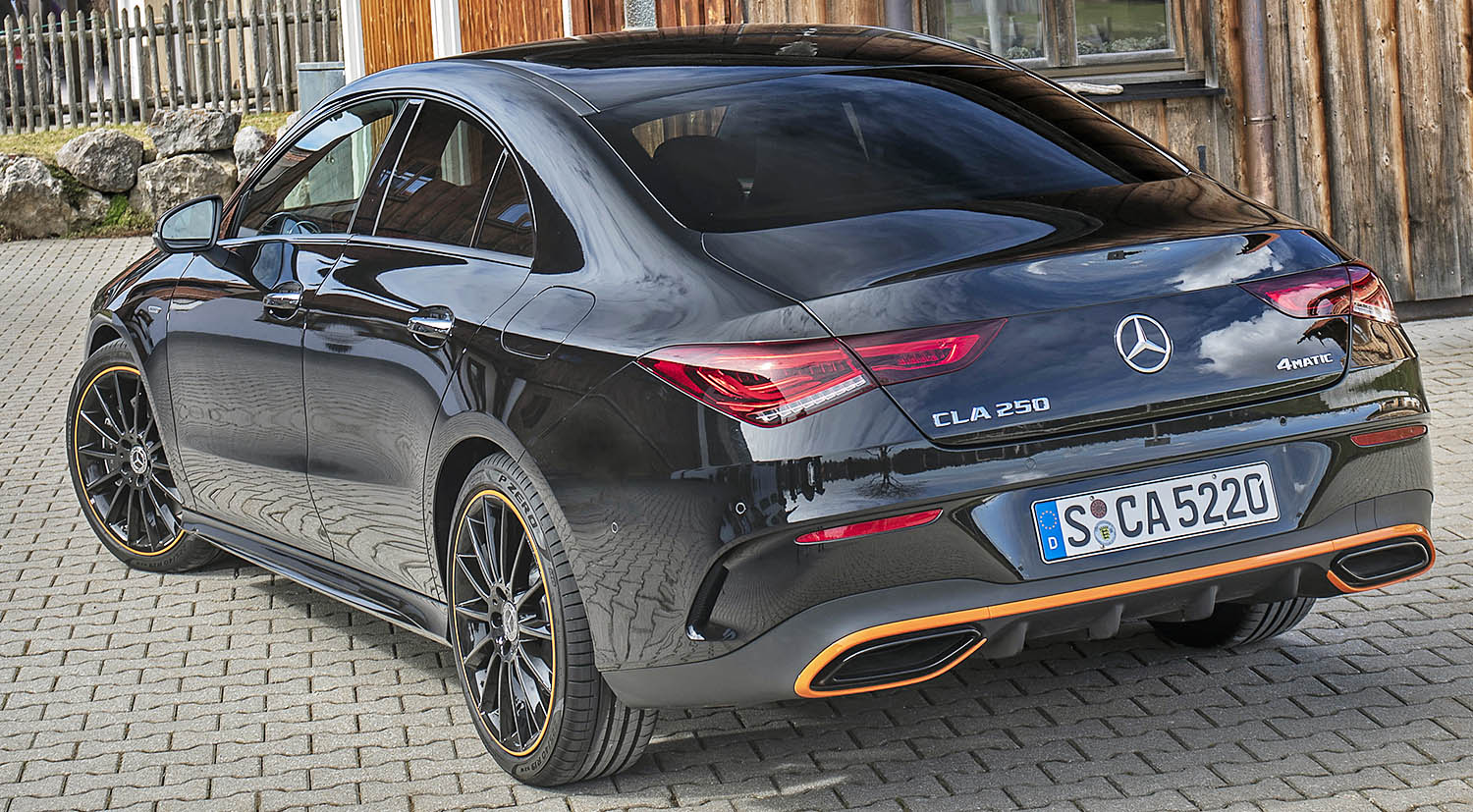
The cool cocoon for digital natives
In the interior, all elements are arranged according to the overarching design themes of ‘high tech’ and ‘youthful avant-garde’ – be that the steering wheel, the door handle operating module, the centre console or the seats. As in the A-Class, the unique interior architecture is shaped in particular by the avant-garde design of the dashboard.
The designers completely dispensed with a cowl above the cockpit. As a result, the wing-shaped main body of the dashboard extends from one front door to the other with no visual discontinuity. The Widescreen display is completely free-standing. This creates a generous sense of space. The high-tech impression of the large screen surface makes its full effect as the centre of attention in the interior.
A horizontal indentation with decorative trim runs along the entire width of the dashboard, dividing the upper and lower part of the dashboard. This band emphasises the width and thus the sense of space. It can be directly or indirectly illuminated by the interior lighting, underscoring the valuable atmosphere of the interior. There are three air vents in the middle which are integrated into the ambient lighting and look like small turbines.
Broad Range: a wealth of individualisation options
The prominence of the large screen alone allows individualisation because the driver can select from several options for the display. The completely free-standing display unit is available in three versions: with two 7-inch displays (17.78 cm), with one 7- and one 10.25-inch display (26 cm) and, in the Widescreen version, with two 10.25-inch displays.
The colours and materials in the CLA Coupé reinterpret the modern luxury of Mercedes-Benz. Depending on the version and the equipment line, black, macchiato beige, bahia brown or two-tone combinations between these or black and red or black and grey can be selected. In keeping with this, the trim elements on the dashboard and doors are either in dinamica, carbon optic, aluminium or open-wood high-quality wooden trim.
The expanded ambient lighting (optional) stages the interior like a work of art with 64 colours and ten colour schemes.
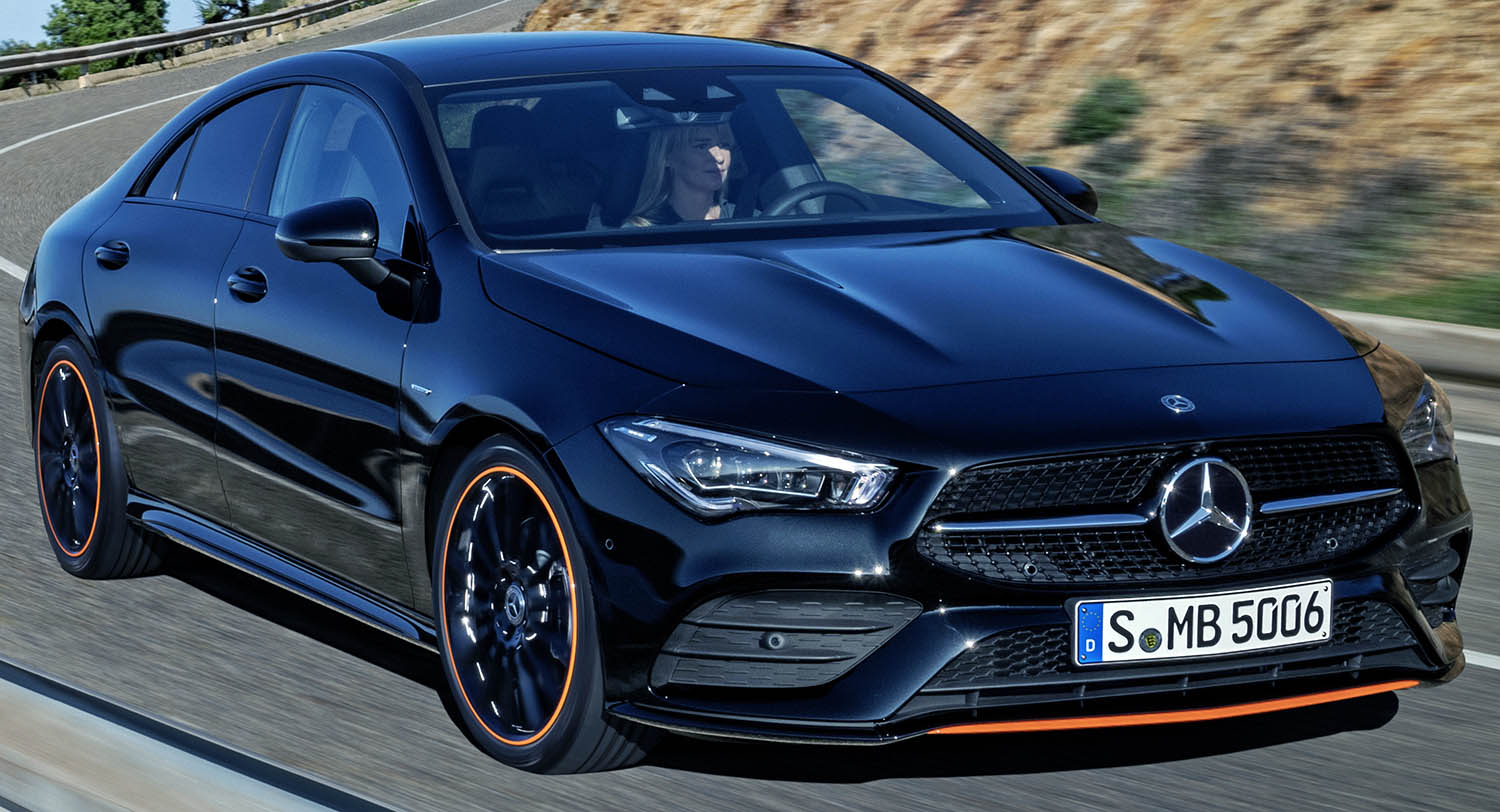
Take a seat: three seating variants and new comfort options
Three different seat variants offer excellent ergonomics and a high degree of comfort even on longer journeys. Alongside the standard seat with straight stitching, a comfort seat with double topstitching is available in conjunction with the Progressive equipment line. The AMG line comes with sports seats in the front as standard. This seat variant is also available for the Progressive line on request. The comfort seats can also be ordered as multicontour seats with electrically controlled air cushions and as an option can not only be heated be also ventilated.
The backrest of the rear seats is 40:20:40 foldable if desired, thus offering through-loading for bulky goods.
Good connection: Space and plugs for smartphones and other devices
There is a touchpad directly to hand in front of the armrest on the centre console between the seats. It is an optional part of the holistic, intuitive touch operating concept – a triad consisting of the media display touchscreen, the touch controls on the steering wheel and the touchpad itself. This can be operated with two fingers and allows zooming into the navigation map as well as leafing through the operating menu on the large screen of the media display if you do not want to stretch your arm out to it. The connections for digital end devices are conveniently housed behind a shutter in the front section of the console. Wireless charging for smartphones that support this function is also available upon request.
There are further connections in the large storage space under the armrest which opens to both sides like butterfly wings at the touch of a button. This means that passengers, for example, can also charge up their devices. Depending on the equipment package, apart from the two cupholders in the front centre console the CLA Coupé also has two more in the centre armrest in the rear. The front door pockets have bottle holders for plastic bottles up to 1.5 litres in size, and in the rear they fit one-litre bottles.
Well-developed in the virtual wind tunnel
In contrast to the predecessor model, the new Mercedes-Benz CLA underwent a much longer phase of aerodynamic optimisation on the computer before the first models were examined in the wind tunnel. The precise digital airflow simulation tool not only made it easy to vary vehicle proportions and to calculate the effects on the aerodynamic drag overnight, it also provided the interrelations between the individual form parameters. This meant that aerodynamic engineers and designers could quickly find a solution that both were satisfied with.
The result also sets standards: a cd value of 0.23. Despite the significantly increased width and wider track, the frontal area of 2.21 m2 corresponds exactly to that of the predecessor model. This was achieved by a slightly lower vehicle height and improvements to the underbody. Overall, this results in an effective aerodynamic drag of 0.51 m², which is only slightly above the value of the currently most aerodynamically efficient series saloon in the world (A-Class Saloon cd=0.22, A=2.19 m², cdA = 0.49 m²).
What sets the new CLA apart from its predecessor: the lower gear ratio spread of the individual variants. During the development process, the declared intention was to bring the variant with the highest aerodynamic drag as close as possible to the best variant, because during certification according to WLTP the higher aerodynamic drag of a wheel or a differently designed diffuser can mean a measurable difference in emissions – and thus even a difference in vehicle tax.
The optimisation work took place in close cooperation with the designers. There was much fine tuning involved, in particular with the rear apron and the diffuser, the radiator grille and the fog lamp recesses. The relief-like diamond-shaped pattern of the fog lamp recesses was reduced to the edge on the Mercedes-Benz CLA for aerodynamic reasons. Totally new are the front wheel spoilers with their fins in the longitudinal direction; they help air to flow around the wheels and the wheel well with minimal losses.
There was also intensive aerodynamic fine tuning with the wheels and tyres – especially with the so-called aerodynamic wheels. These produced optimum aerodynamic values while also having an attractive appearance thanks to the close cooperation with the designers. The two-part AIR PANEL comes as standard behind the radiator grille. This is a shutter system that regulates the air flow through the engine compartment. The almost complete underbody panelling encompasses the engine compartment, the main floor, parts of the rear axle and the diffuser.
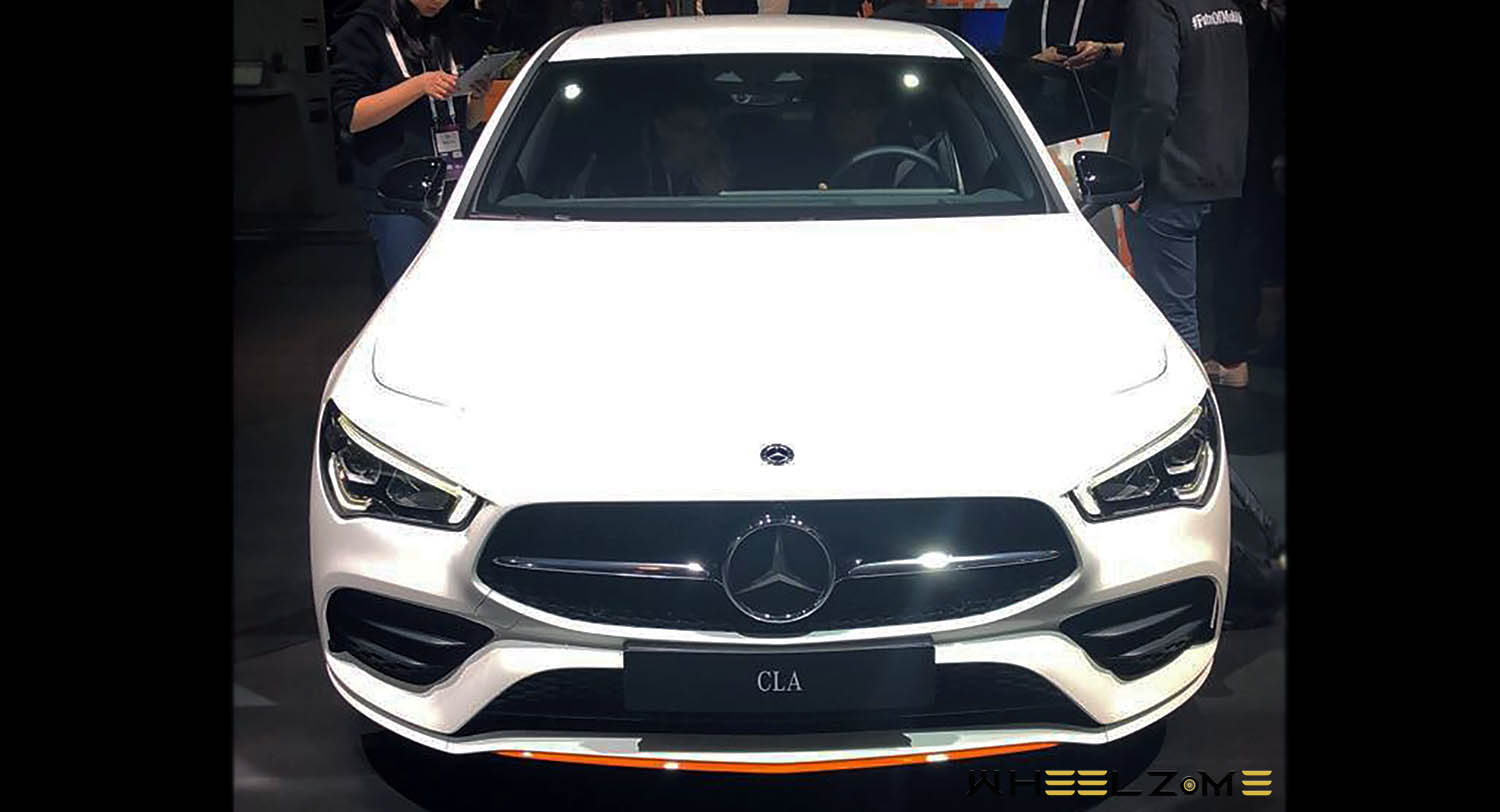
MBUX keeps on learning
In 2018, MBUX – the Mercedes-Benz User Experience – created a furore at its world premiere at CES in Las Vegas. With high-performance chips and innovative hardware components such as high-resolution screens and brilliant 3D graphics partially generated in real-time, an individualisable display, full-colour head-up display, navigation with augmented reality and software that is capable of learning, Mercedes-Benz is revolutionising how the car is operated. And communication with it: “Hey Mercedes” is the keyword for voice control that explodes conventional automotive standards. The CLA ignites the next stage of MBUX.
The optional MBUX Interior Assistant is new. It makes natural operation even easier. By recognising movements MBUX Interior Assist brings added intelligence to the interior. And the voice control feature recognises topical answers in a growing number of domains in German and English to start off with. The continuous development of the system successively expands this option to further languages and also accesses country-specific content providers.
The information of the instrument cluster and central display is easily legible on the large, high-resolution screens. An emotive presentation underlines the comprehensibility of the intuitive control structure and offers brilliant graphics in top visual quality.
Depending on mood or to suit the chosen interior, the user has a choice of three different styles:
- Modern Classic is a further development of the classic display style in an elegant-light and exquisite material mix.
- Sport has a high-tech turbine look with decidedly sporty black/yellow contrasts.
- Progressive stages the digital in a reduced form and visualises modernity in highly aesthetic glass lenses.
“The newest version of voice control for MBUX – the Mercedes-Benz User Experience – can be experienced in the new CLA. For example, the voice assistant ‘Hey Mercedes’ is able to recognise and answer considerably more complex queries,” says Sajjad Khan, Member of the Divisional Board of Mercedes-Benz Cars for CASE. “What’s more, the voice assistance no longer gets confused by other passengers conversing. Instead it only responds to the commands of the person who last said ‘Hey Mercedes’ to activate the system – and you can retain your natural speech rhythm while using the system.”
MBUX Interior Assistant: An even greater experience
By recognising movement, the MBUX interior assistant imparts additional intelligence to the interior and makes operating various comfort and MBUX functions even simpler and more intuitive for the passengers. Interior Assist operates in non-contact mode and functions both in sunlight and in complete darkness.
It adapts the screen content as soon as a hand approaches the touchscreen in the dashboard or the touchpad on the centre console, for example. Individual elements are highlighted according to the currently active menu. The system is able to distinguish between the driver’s and front passenger’s wishes and thus knows for whose seat the massage function is to be activated, for example.
A special feature of Interior Assist is the personal favourites function. It is accessed by horizontally holding a hand over the centre console with the index and middle finger spread in a V-shape. In this way, any command which is controllable via MBUX can be stored for simple access. One typical favourite command is “navigate me home”. As the system is able to reliably recognise who is operating it, the driver and front passenger respectively can even assign different favourites to the same hand position.
There are other functions which can be controlled intuitively, without any need to practise corresponding gestures: In the dark, the reading lamp can be switched on and off by briefly extending a hand towards the rear-view mirror, for example. If the driver reaches over towards the unoccupied front passenger seat in the dark, it will be illuminated automatically. This makes it easier to find any items which may have been deposited on the seat. As soon as the person’s hand leaves this area, the light automatically switches off again.
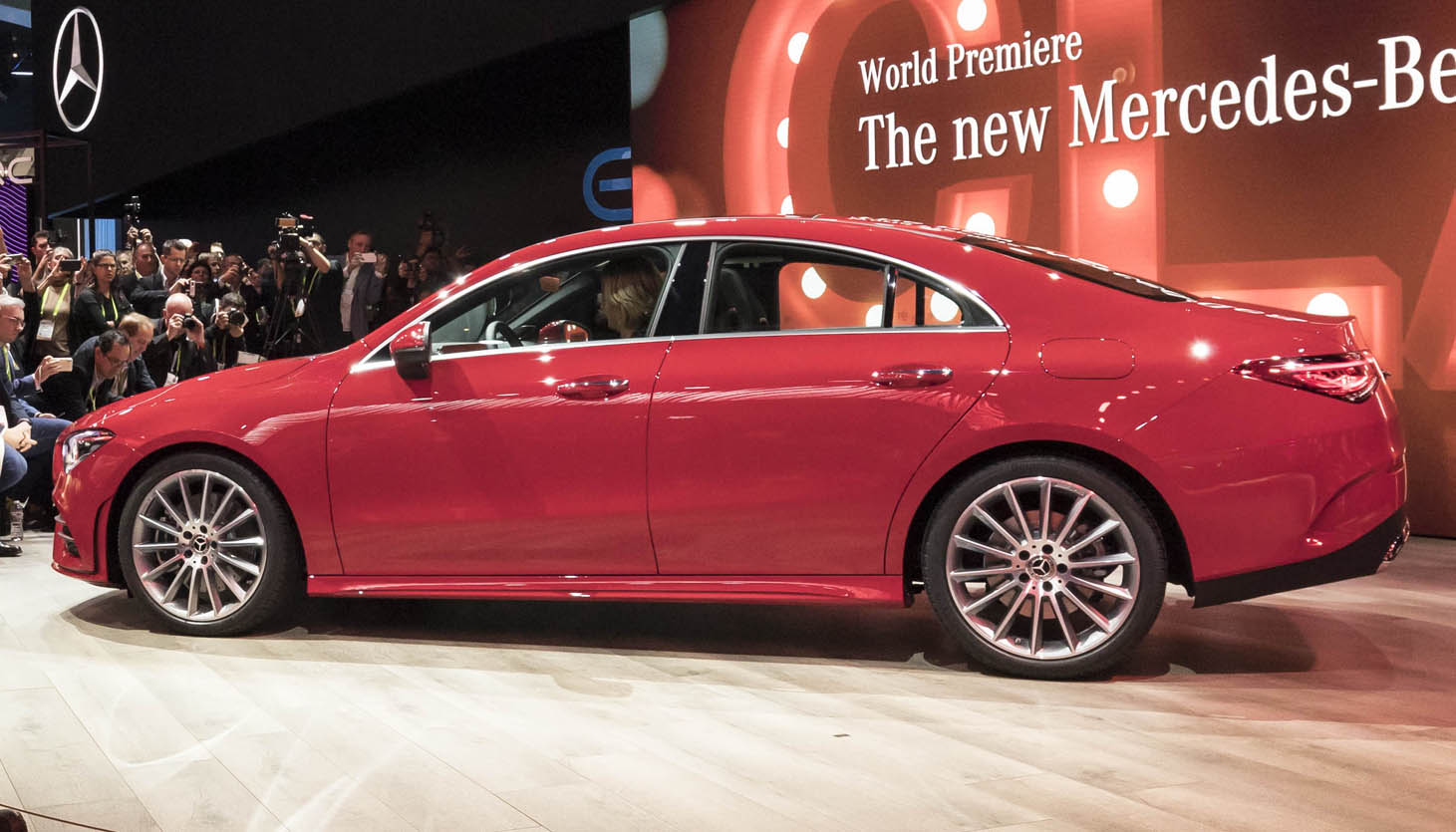
“Hey Mercedes”: better understanding and even cleverer responses
State-of-the-art of voice control can also be experienced in the Mercedes-Benz CLA. Here too seat recognition has been implemented. The voice assistance only responds to the commands of the person who last said “Hey Mercedes” to activate the system. In the American market initially, the voice assistant can recognise and respond to considerably more complex queries, for example: “Which child-friendly Asian restaurants are nearby which are neither Chinese nor Japanese?” There is also a growing number of domains for which MBUX can understand complex questions and quickly reply: these include sport (“Hey Mercedes, what was the final score in the football games this evening?”), the stock exchange (“How have the share prices developed in the past week on Wall Street?”), calculations (“What is the square root of 3?”) or general knowledge (“How big is Texas?”, “What is the fat content of avocados?”).
Modular structure: new tailor-made user experience
The MBUX functions are modular in structure, so that the precise needs of different customers can be met. As standard this has two 7-inch displays for the instrument cluster and media display with touchscreen, a multifunction sport steering wheel with touch control buttons on the left and right, a USB interface (Type C), a Bluetooth® connection for telephony and audio sources.
MBUX can be complemented with the following options (packages apply to the German market), whereby many services can also be activated later by updates:
- Basic navigation package: extended MBUX functions (including intelligent voice control with “Hey Mercedes”), navigation, pre-installation for Live Traffic Information and touchpad.
- Display Package: 10.25-inch instrument cluster, 10.25-inch media display and touchpad.
- Premium navigation package: 10.25-inch instrument cluster, 10.25-inch media display, extended MBUX functions (including intelligent voice control with “Hey Mercedes” and wifi hotspot), navigation, pre-installation for Live Traffic Information, pre-installation for digital radio; touchpad and Traffic Sign Assist.
- MBUX Augmented Reality Navigation: A video image of the surroundings taken with the aid of the front camera is augmented with helpful navigation information, for example arrows or house numbers are automatically superimposed directly onto the touchscreen of the media display.
- MBUX Innovation Package: This includes the MBUX Interior Assistant as well as the head-up display.
- Head-up display: Important information is projected into the windscreen directly in the driver’s field of vision, reducing distraction from the traffic situation. There is also less eye fatigue for the driver, as the eyes do not constantly have to refocus between close-up and long-distance vision.
- Multifunction telephony: connects the smartphone to the vehicle’s exterior antenna. Data transmission benefits from this, as does making calls. Compatible mobile phones charge wirelessly and network with the vehicle via Near Field Communication (NFC).
- Burmester® Surround Soundsystem with 12 loud speakers and a system output of 590 watts.
New and improved Mercedes me connect services are part of the new infotainment generation MBUX. The Mercedes me in-car apps can be placed as an icon on the screen in a user-friendly way, and can be freely sorted on the homepage like all other main applications. The individual Mercedes me connect services have been bundled together into equipment packages, for example Vehicle Monitoring, Live Traffic Information and the Digital Vehicle Key.
Wellness on wheels
ENERGIZING comfort control networks various comfort systems in the vehicle, and uses musical and lighting moods plus a number of massage modes for a wide range of feel-good programmes. The new ENERGIZING COACH recommends situative programmes. Also new are the ENERGIZING seat kinetics. The system supports advantageous changes in the seating posture by means of minute movements of the seat cushion and backrest when on a journey.
There are two ENERGIZING packages to choose from: The ENERGIZING package includes the Freshness and Vitality as well as the Training programmes (three training sessions – muscle relation, muscle activation and balance – each with several exercises). The training can also be carried out while on the move. In addition, in the ENERGIZING Package plus, the Heat, Pleasure and Comfort programmes are also available.
Each programme is designed for ten-minute period. They are visualised on the media display with colour graphics, and backed by suitable music, among other things. The main function of the “Joy” programme is massage, for example. There is also music which further underscores the mood of the programme on account of its rhythm. If personal music selections are available, e.g. via the Media Interface, the system analyses them in the background and assigns them to a programme based on the beats per minute. Individual functions of the programmes can be deactivated.
ENERGIZING comfort control also incorporates the ambience lighting, which is harmoniously tailored to each of the individual screen designs. The light stages the interior like a work of art by composing colour worlds from different colours, thereby creating a new, holistic comfort experience.
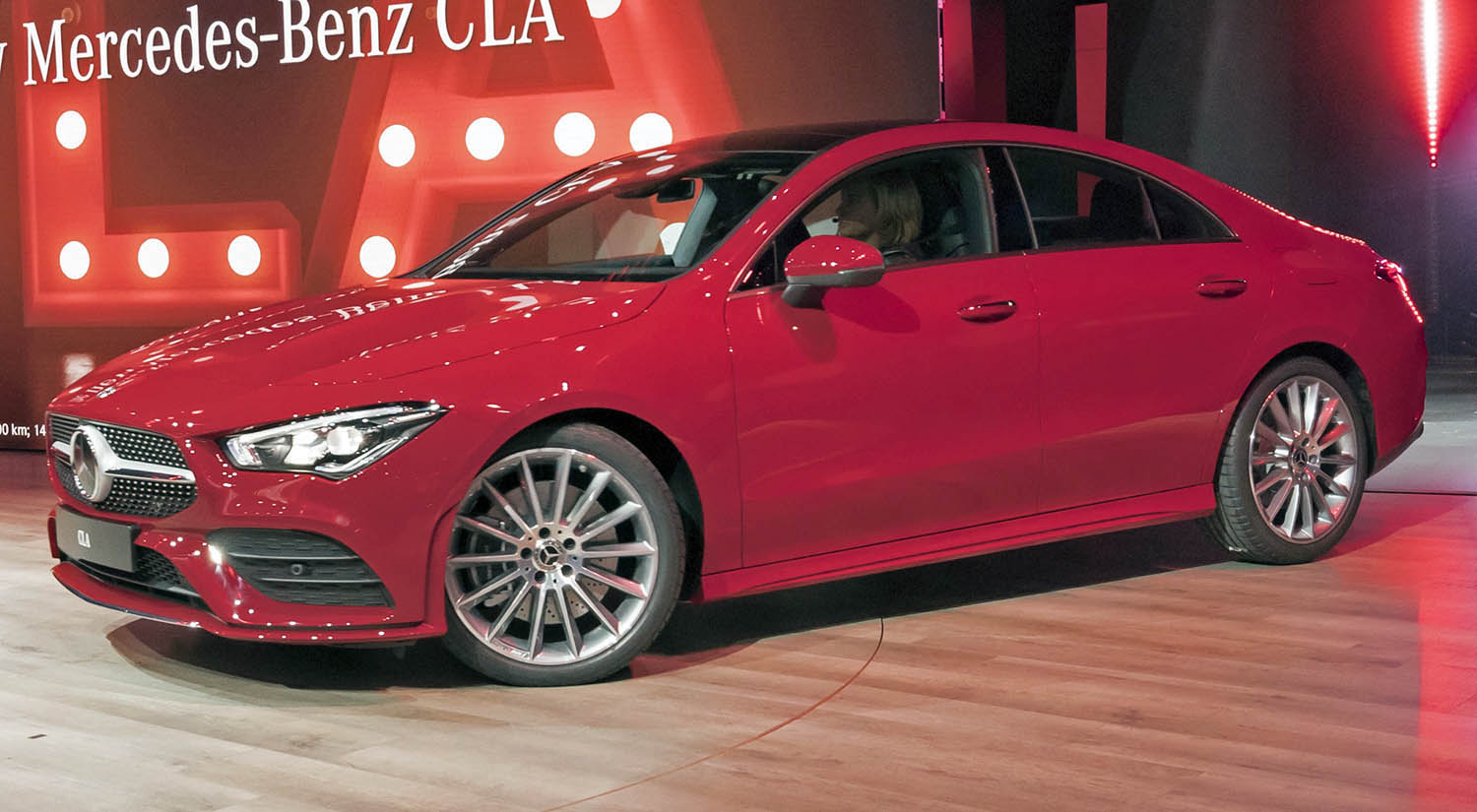
ENERGIZING COACH: Comfort with instructions
The ENERGIZING COACH is a new feature. This function based on an intelligent algorithm recommends one of the programmes depending on the situation and individual. If the Mercedes-Benz vivoactive® 3 smartwatch or another compatible Garmin® wearable is linked, personal values such as stress level or sleep quality optimize the precision of the recommendation. The aim is for passengers to feel well and relaxed even during demanding or monotonous journeys. In addition, the pulse rate supplied by the integrated Garmin® wearable is shown on the media display.
Agilely stylish
When it comes to driving dynamics, the new CLA keeps good on its design promise and on request can be individualised with active adjustable damping. The first striking feature is the wide track compared to its predecessor (an extra 63 mm at the front and 55 mm more at the rear) which, in connection with its lower centre of gravity, give the CLA the sportiest driving characteristics of all models in the new generation of compact cars from Mercedes-Benz.
The CLA comes as standard with a comfort suspension with steel springs and McPherson suspension struts at the front. There is a decoupled multi-link axle at the rear for reduced noise and vibration. This suspension can optionally be ordered in a lowered version. Stabiliser bars with a larger diameter at the front and rear reduce body roll.
As an option, an active adaptive damping system is available, giving the driver the choice between more comfort or a more sporty tuning. It reacts instantly and modifies the tuning depending on the situation. Sensors constantly gauge the condition of the suspension and the driving situation, and optimally adapt the damping individually at each wheel via a controllable valve in the shock absorber.
The range of wheels starts at 16 inches and goes up to 19 inches with tyre sizes starting at 205/60 R 16 and ending as standard at 225/40 R 19. In contrast to the predecessor model, the range of aerodynamically efficient aero-wheels in particular has been increased. The ESP® has been specially adapted to the CLA’s potentially high cornering speeds and handling performance.
Watchdog
The Mercedes-Benz CLA has the very latest driving assistance systems with cooperative driver support, and thus provides the highest level of active safety in this segment with functions adopted from the S Class. The high-performance light from the MULTIBEAM LED headlamps takes the fright out of night-time driving and self-adjusts to the traffic situation. For the first time, the CLA is able to drive semi-autonomously in certain situations.
To do this, it keeps a close eye on the traffic situation. Improved camera and radar systems allow it to see up to 500 metres ahead. The CLA also uses map and navigation data for assistance functions. For example, Active Distance Assist DISTRONIC as part of the optional Driving Assistance Package is able to provide route-based support to the driver in numerous situations, and to predictively and conveniently adjust the speed, e.g. when approaching bends, junctions or roundabouts. Also on board are e.g. Active Emergency Stop Assist and intuitively understandable Active Lane Change Assist.
The new CLA comes with enhanced Active Brake Assist as standard. Depending on the situation, it can effectively help to mitigate the consequences of rear-end collisions with slower-moving, stopping or stationary vehicles ahead, and even with crossing pedestrians and cyclists, or to prevent them altogether.
Active Lane Keeping Assist (likewise standard) is able to warn the driver by means of pulsed vibrations in the steering wheel when the vehicle is unintentionally drifting out of its lane at speeds between 60 and 200 km/h. If the vehicle passes over a solid line, it can pull the vehicle back into lane by applying the brakes on one side. In the case of a dotted line, such intervention takes place only when there is a danger of collision with a vehicle in the adjacent lane (danger from oncoming traffic).
PRE-SAFE® PLUS can detect an imminent rear-end collision. If the danger of a collision persists, the system can also firmly apply the brakes of the stationary vehicle, thus lowering the risk of injuries by reducing the forward jolt caused by an impact from the rear.
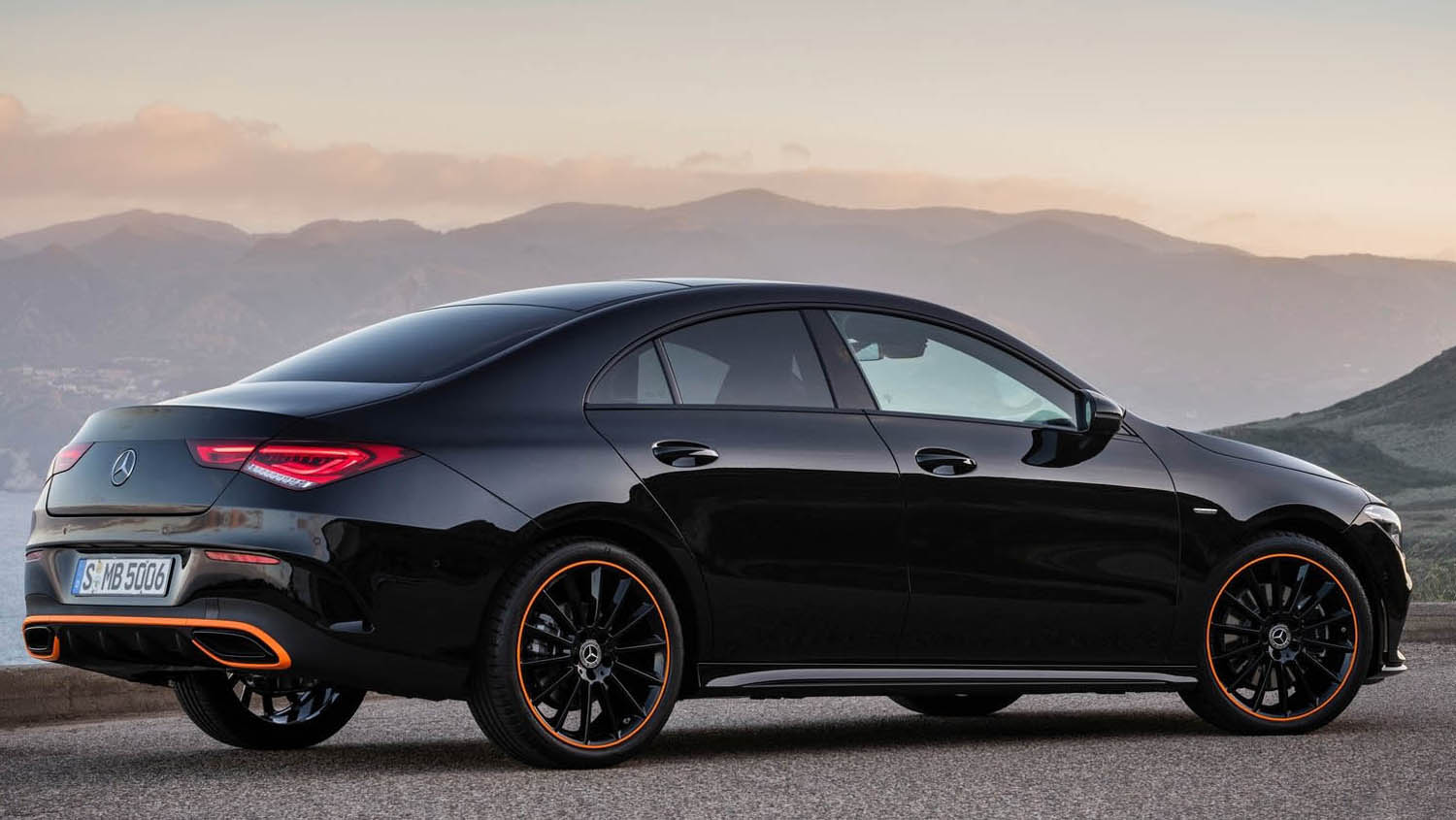
MULTIBEAM LED headlamps: better sight
Another example of automotive intelligence and the transfer of technology from the luxury segment to the compact class are the optional MULTIBEAM LED headlamps. They allow extremely quick and precise, electronically controlled adjustment of the headlamps to suit the current traffic situation. Each headlamp on the Mercedes-Benz CLA incorporates 18 individually controllable LEDs. The daylight-like light colour of the LEDs is easy on the eyes and has a positive effect on concentration. The road ahead is precisely and brightly illuminated. In addition, the Highbeam Assist Plus can be ordered, which prevents oncoming traffic from being blinded while at the same time using the full performance of the headlamps where it does not bother anyone.
LED High Performance headlamps are a further option. As standard, the new CLA is equipped with halogen headlamps with integrated LED daytime driving lamps. The tail lamps are also available with all-LED technology.
Clean, strong and comfortable
The new CLA relies on the four-cylinder petrol and diesel engines which were completely updated to relaunch the compact model series. In comparison to the previous generation, they are characterised by significantly increased power, improved efficiency and emissions. In keeping with the sporty character, the Coupé is being launched with a petrol and diesel engine initially with 180 hp. Both two-litre diesel engines (OM 654q) already fulfil the Euro 6d standard which does not come into force until 1.1.2020 for new models. In addition, 4MATIC all-wheel drive is available for some variants.
The M 282 petrol engine: four-cylinder with cylinder shutoff
The M 282 with a displacement of 1.33 litres forms the point of entry to the range of petrol engines in the CLA 180 and CLA 200. The engine excels with very compact dimensions, low weight (approx. 110 kg dry) and high static and dynamic rigidity. An electronically controlled wastegate and flexible charge pressure control ensure optimal charge pressure over the entire rpm and load range and thus efficiency and power when starting off.
For efficient partial-load operation, this engine initially in combination with the 7G-DCT transmission (CLA 180 6-speed manual available from June 2019) also has cylinder shutoff. Depending on the power requirement, in the range between 1250 and 3800 rpm the intake and exhaust valves of the second and third cylinder are closed by valve clearance adjustment. The remaining two cylinders therefore operate under higher loads, and therefore more efficiently. To minimise friction, the cylinder walls are coated using the patented NANOSLIDE® process and the piston skirts with a very hard-wearing Eco-Tough coating with graphite. The new compact four cylinder engine (10.6:1) comes with a particulate filter as standard and runs especially quietly thanks to extensive insulation and damping. The M 282 is produced in the Kölleda plant in Thuringia. It is combined with the six-speed manual transmission or the 7G DCT dual-clutch transmission.
The M 260 petrol engine: Trumpet-honing and variable valve timing system
In its engine block of die-cast aluminium, the two-litre M 260 engine from the more powerful CLA petrol variants has cast iron cylinder liners whereby the cylinder bore is widened at the lower end in line with the CONICSHAPE® principle, also known in-house as “trumpet-honing”. This minimises piston friction and lowers fuel consumption along with new low-friction oil and optimised piston rings. The pistons themselves feature cooling ducts to take account of the higher specific output. The balance shafts for smooth engine-running are located in the lower section of the crankcase.
In the aluminium four-valve cylinder head, the CAMTRONIC variable valve timing system allows two-stage adjustment of the valve lift on the intake side. In the partial-load range with a smaller valve lift it reduces the load quantity and thus lowers gas cycle losses. In higher load ranges the system switches to the higher valve lift to achieve the engine’s full power delivery. The direct injection uses the latest-generation piezo injection valves. Their installation position and control are meant to avoid raw emissions especially of particles. A particulate filter is also standard with the M 260.
All of the measures, including the precisely regulated geometry of the turbo charger with wastegate, make the engine quiet, powerful, economical and low in emissions. It is configured for front-wheel drive and 4MATIC all-wheel drive, and combined with the 7G-DCT dual clutch transmission. The M 260 engine is produced by the Kölleda plant.
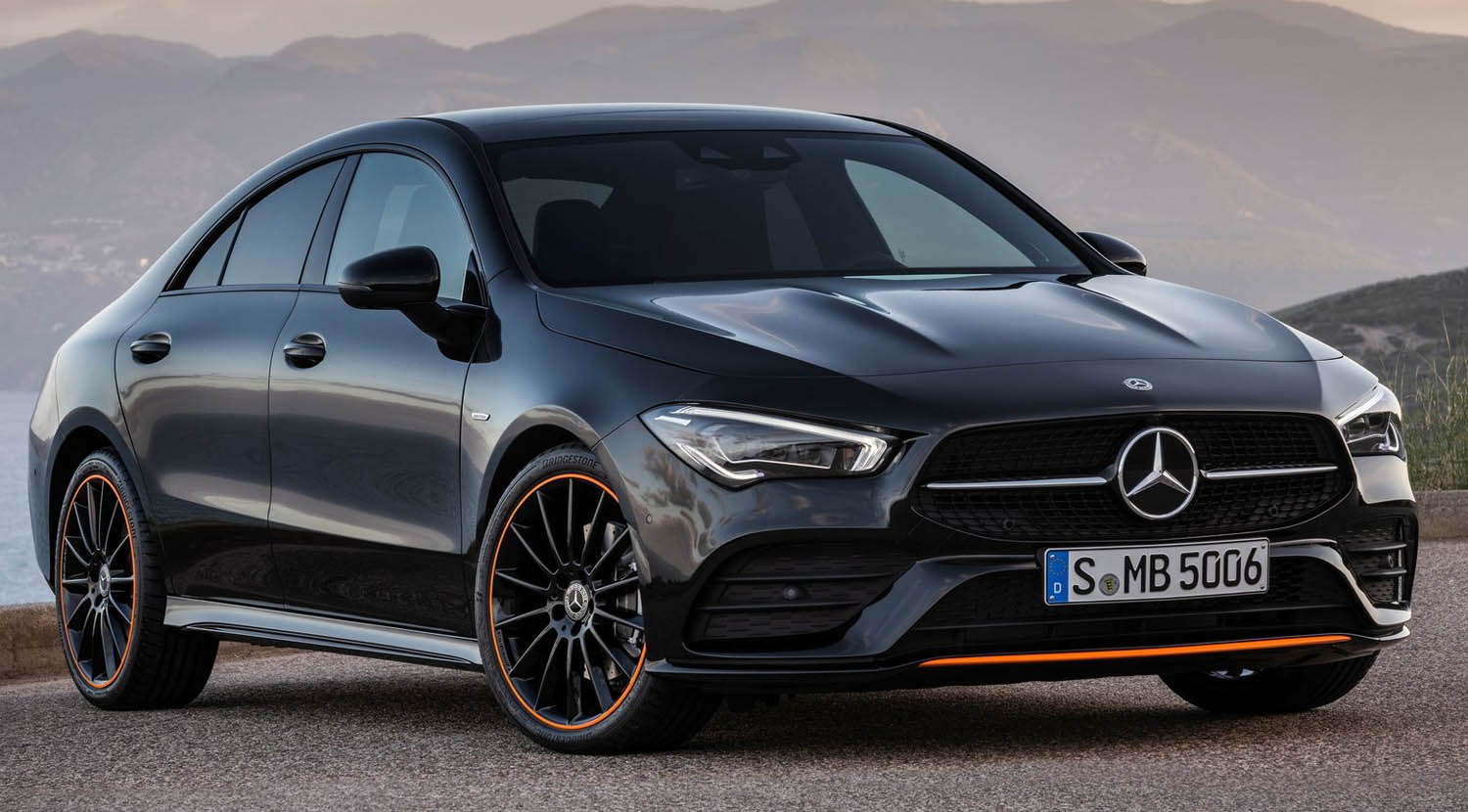
The OM 654q diesel engine: already certified according to Euro 6d
The more powerful diesel versions of the new Mercedes-Benz CLA have the current premium OM 654q two-litre diesel engine adapted for transverse installation. On the inside, the OM 654q offers efficiency-enhancing technological highlights such as steel pistons with stepped bowls in an aluminium block. The cylinder liners are coated using the further-improved NANOSLIDE® process.
The compact engine allows all components of the exhaust aftertreatment system to be installed directly on the engine itself where the exhaust temperature is higher, making for more efficient aftertreatment. Thanks to further improved exhaust aftertreatment, the powerful four-cylinder from the modern OM 654 engine family already meets the Stage 2 RDE (Real Driving Emissions) standard coming into force from 2020, and is certified to Euro 6d. (More information on RDE in the next chapter: Under the microscope – Real Driving Emissions).
Thanks to the near-engine insulated configuration, the emission control system has little heat loss and ideal operating conditions. The measures taken include
- high- and low-pressure exhaust gas recirculation including cooling,
- a diesel oxidation catalytic converter (DOC) to avoid the emission of carbon monoxide (CO) and unburned hydrocarbons (HC),
- a particulate filter with SCR catalytic function (sDPF),
- an SCR catalytic converter (selective catalytic reduction) for reducing nitrogen oxides. For this purpose, ammonia in the form of the carrier AdBlue® is added to the exhaust gases before entering the sDPF,
- an additional selective catalytic reduction (SCR) converter with an ammonia slip catalyst (ASC) in the exhaust tract.
The engine offered in two power variants in the CLA 200 d (110 kW/150 hp) and in the CLA 220 d (140 kW/190 hp) delivers its superior power to the
8G DCT dual clutch transmission. The gear ratios are closer together on account of the additional gear range, which makes for enhanced ease of shifting and extends the possibility of using the engine in the best possible operating point. At the same time, the 8th gear has a longer ratio, and at constant speeds on the motorway, for example, rpm is decreased which is good for efficiency and noise comfort.
The OM 608 diesel engine: point of entry with 116 hp
The development of the entry-level OM 608 diesel engine in the Mercedes-Benz CLA 180 d focused on higher power with reduced exhaust gas and noise emissions. To this end, charging in particular was overhauled and now features electrically controllable turbo charger geometry and an engine-mounted water intercooler, valve assembly with reduced moving masses and the common rail injection system. Its intake manifold is now integrated into the cylinder head cover and the pressure of the common-rail injection system has been increased to 2000 bar (previously: 1600 bar).
The electro-magnetically controlled injectors with eight injection holes precisely control combustion by up to six injections per working cycle. Dual pre-injection in wide operating ranges and injector shaft seals reduce operating noise.
For low emissions the OM 608 is equipped with high and low-pressure exhaust gas recirculation. The compact exhaust aftertreatment system is near-engine mounted. Alongside the oxidation catalytic converter and the particulate filter, SCR catalytic converters with AdBlue® metering are used for the first time in this engine class. The particulate filter also has an SCR coating. An AdBlue® tank with a capacity of 23.8 litres ensures long refilling intervals for the OM 608 and OM 654q diesel variants, and has its own, externally accessible filler neck next to the diesel filler neck. This is in the tank flap directly beside the diesel tank nozzle.
The OM 608 is combined with the 7G-DCT dual-clutch transmission or the six-speed manual transmission (from June 2019).
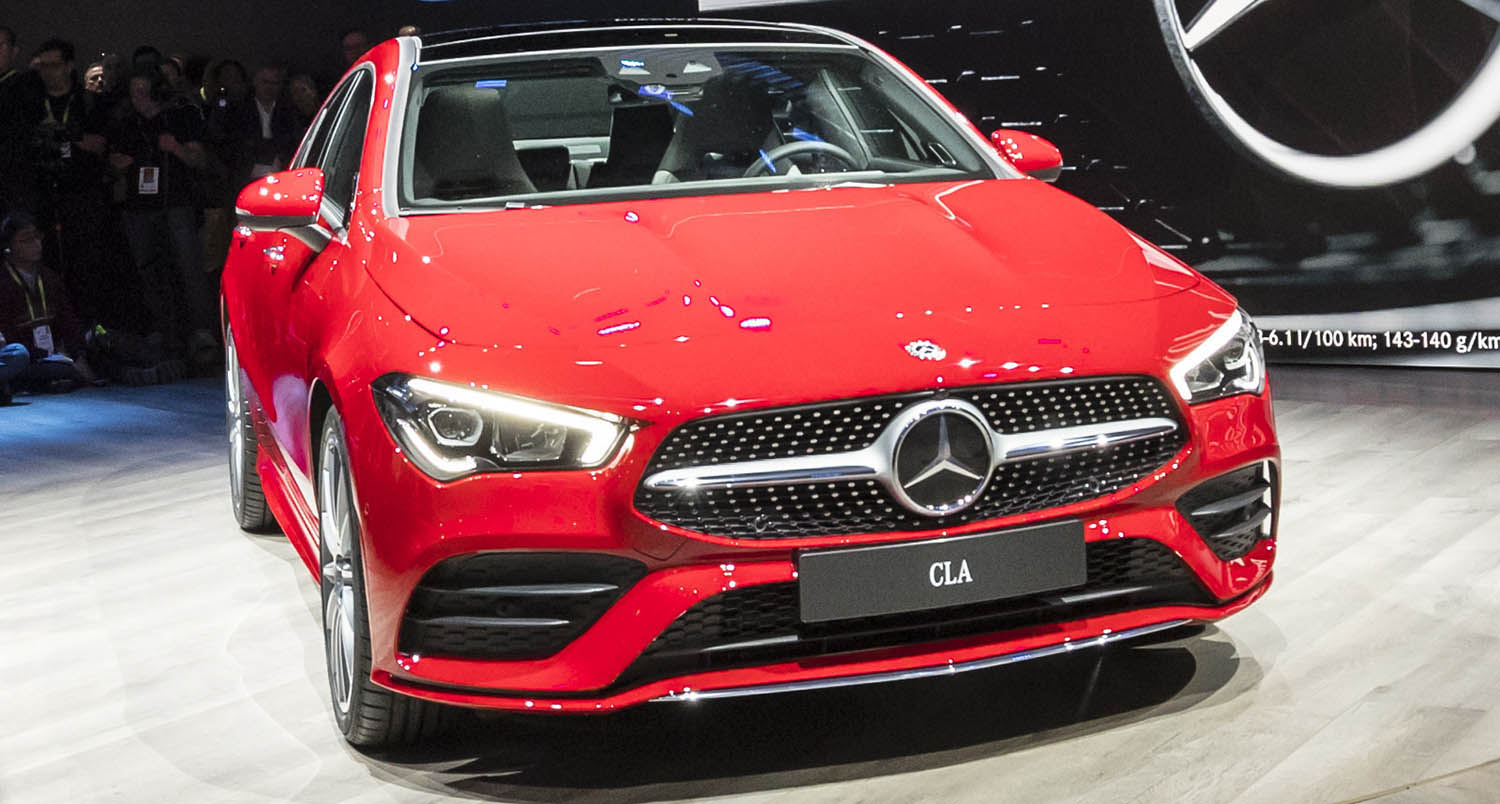
Realistic verification of lab values
As the football saying goes: “Performance on the pitch is what matters”. When measuring emissions, the same applies to performance on the road. For this reason, according to the Euro 6d-TEMP standard and the even more far-reaching Euro 6d standard, the lab measurements according to the WLTP are supplemented by the so-called RDE test (Real Driving Emissions). Pollutant emissions (including nitrogen oxide and particles) are measured in vehicles directly on the road and compliance of limits with conformity factors is checked.
The additional RDE test is intended to allow the pollutant emissions to be tested under real driving conditions. In contrast to a lab test, the RDE test does not follow a set driving cycle. Instead, the emissions are tested under real driving conditions with legally defined permissible ambient conditions. For the RDE test, the vehicle is equipped with a so-called PEMS (Portable Emissions Measurement System).
The RDE measurements normally take place in parallel to the WLTP dynamometer tests. WLTP system authorisation via the model testing authority is only granted if the manufacturer can present valid RDE measuring drives and can confirm compliance with the RDE requirement.
Parameters include (examples):
- Driving time between 90 and 120 minutes
- Speed-based split of driving into 34 percent urban (but at least 29 percent of the route), 33 percent extra-urban and 33 percent motorway. To allow for changing traffic conditions, a tolerance of +/- 10 percent is permitted for these values.
- Each route (urban/extra-urban/motorway) must be at least 16 km long.
- The speed ranges are
- urban: 0 to 60 km/h (average speed 15-40 km/h); several stop phases of 10 seconds or longer (max. 300 seconds) are permitted; the stop phases may account for 6-30 percent (time-based).
- extra-urban: 60 to 90 km/h
- motorway: between 90 and max. 160 km/h.
- The elevation difference between the start and end points of the route must be no more than 100 metres; the cumulative elevation gain per 100 km must be no more than 1200 metres; the maximum absolute elevation is 1300 metres.
- The weight of the vehicle may be max. 90 percent of the total of the “mass of the passengers” and the “payload”.
- The ambient temperature must be between -7°C and +35°C.
For vehicles undergoing an RDE test as part of the Euro 6d-TEMP or Euro 6d emissions standard, the emissions limits of the Euro 6 standard plus so-called conformity factors must be complied with. For nitrogen oxide, this conformity factor in Phase 1 of RDE (new passenger car approvals are possible up until 31 December 2020) is 2.1, for the particle number 1.0 +0.5. The value of 0.5 for the particle number corresponds to a measuring tolerance of 0.5 which illustrates variations in the measurement technology. The vehicle must technically comply with the particle limit of 6*10^11 per km in an RDE drive.
In RDE Phase 2 (Euro 6d), which applies to new models from 1 January 2020 and/or to all newly approved cars from 1 January 2021, the factor for nitrogen oxide is 1.0 + 0.43; the 0.43 value corresponds to the measuring tolerance. On 13.12.2018 the European General Court (EGC) made an initial decision on the EU Commission’s responsibility for certain regulations on the RDE tests. The European Commission lodged an appeal against this with the European General Court (EGC). If the judgement becomes legally binding, it could lead to a fundamental reassessment of the conformity factors.
The legally defined permissible range for an RDE test covers a wide field of application, e.g. it allows speeds of up to 160 km/h, temperatures down to -7 °C and driving in mountainous terrain.
The limits with the above-mentioned conformity factors are to be observed. Since the limits have to be fulfilled under all possible combinations of the parameters, emissions in real-life customer operation are generally significantly below the prescribed limits.
Independent technical services take on the certification drives
Car manufacturers currently have to have at least 50 percent of the drives carried out by technical services for RDE certification. Mercedes-Benz has transferred all of these tests to external independent organisations. As part of field validation, official test institutes as well as e.g. private environmental organisations can in future conduct their own RDE tests within the previously mentioned parameters.

